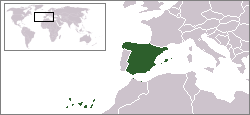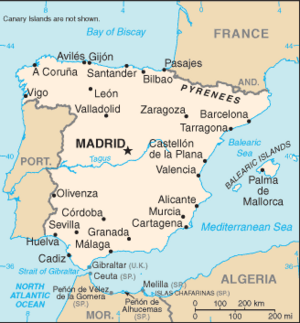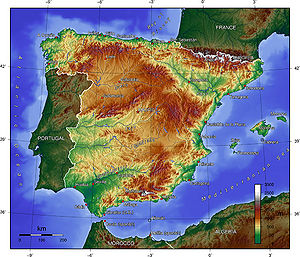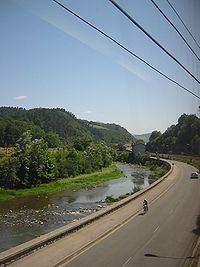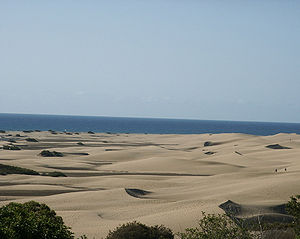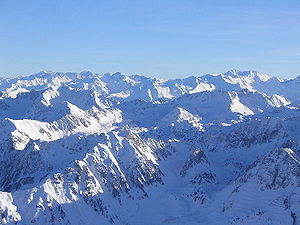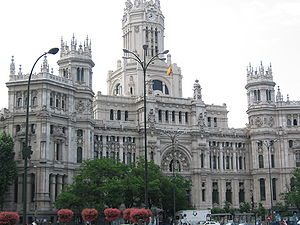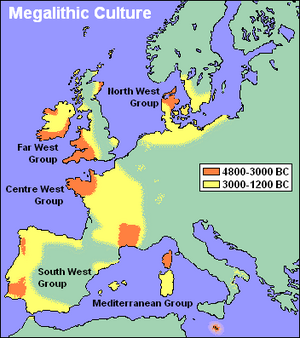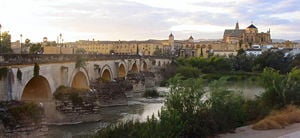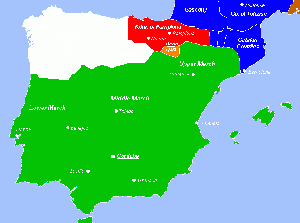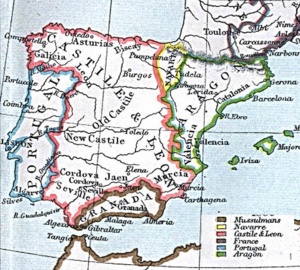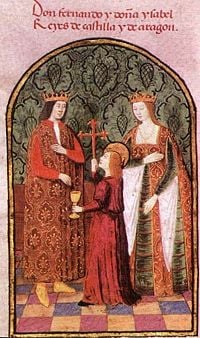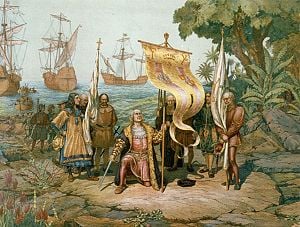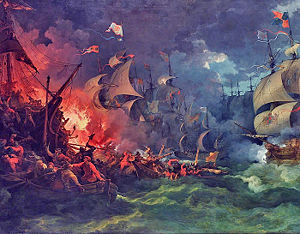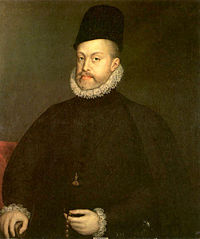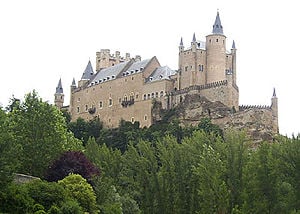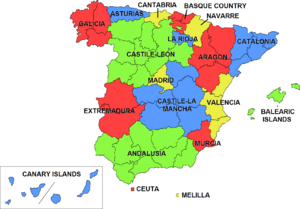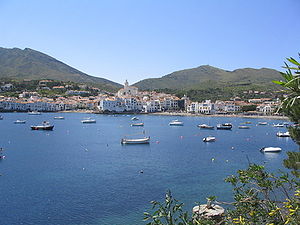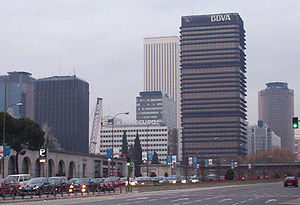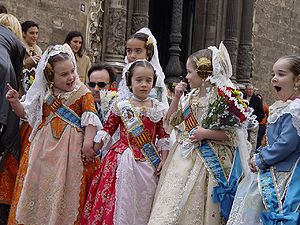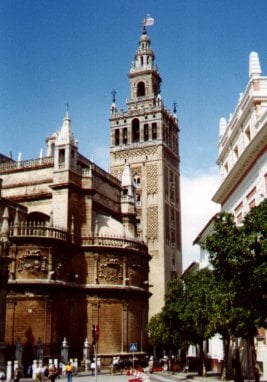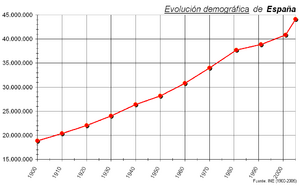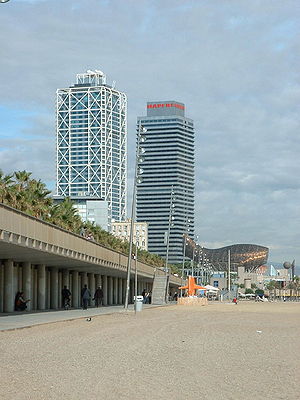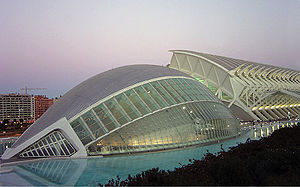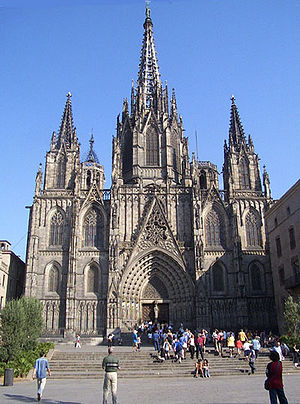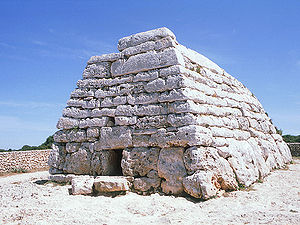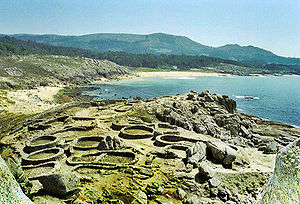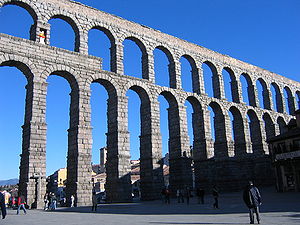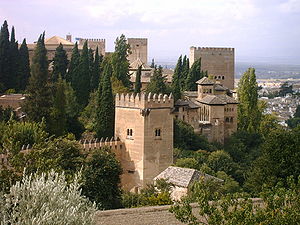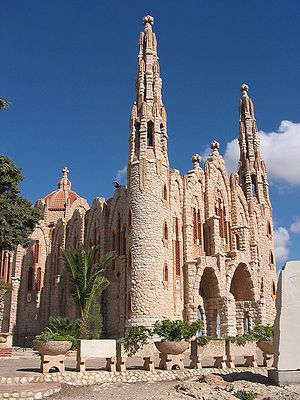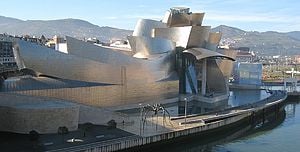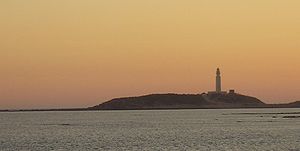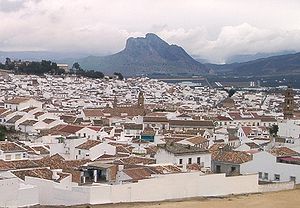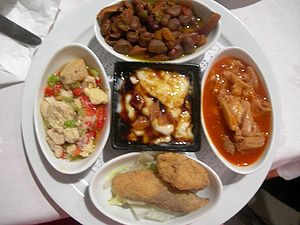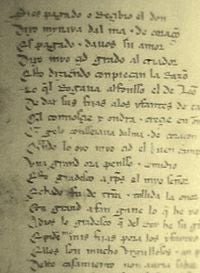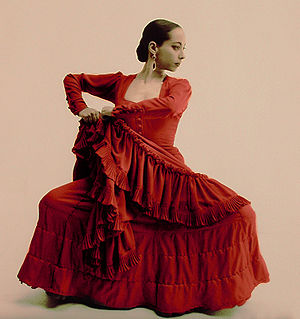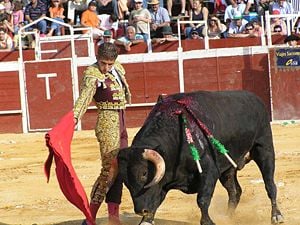Difference between revisions of "Spain" - New World Encyclopedia
Mike Butler (talk | contribs) |
Mike Butler (talk | contribs) |
||
| Line 172: | Line 172: | ||
[[Image:Iberian Union Empires.png|thumb|300px|left|A map of the Spanish and Portuguese Empires in the period of [[Iberian Union]] under the [[personal union]] of the Spanish monarchs (1580-1640).]] | [[Image:Iberian Union Empires.png|thumb|300px|left|A map of the Spanish and Portuguese Empires in the period of [[Iberian Union]] under the [[personal union]] of the Spanish monarchs (1580-1640).]] | ||
[[Image:Columbus Taking Possession.jpg|thumb|300px|left| Columbus setting foot on the New World.]] | [[Image:Columbus Taking Possession.jpg|thumb|300px|left| Columbus setting foot on the New World.]] | ||
| − | + | The unification of Castile and [[León]], Aragón and [[Navarre]] became the base of what is now referred to as the [[Spanish Empire]], the first modern [[Global Empire|global empire]], and one of the largest empires in world history. In the sixteenth century, Spain and Portugal led European global exploration and colonial expansion and the opening of trade routes across the oceans, with trade flourishing across the Atlantic between Spain and the [[Americas]] and across the [[Pacific]] between [[East Asia]] and [[Mexico]] via the [[Philippines]]. [[Conquistador]]s toppled the [[Aztec]], [[Inca Empire|Inca]] and [[Maya civilization|Maya]] civilizations and laid claim to vast stretches of land in [[North America|North]] and South America. For a time, the Spanish Empire dominated the oceans with its experienced [[Spanish navy|navy]] and ruled the European battlefield with its fearsome and well trained infantry, the famous ''[[tercio]]s'': in the words of the prominent French historian Pierre Vilar, "enacting the most extraordinary epic in human history". Spain enjoyed a [[Spanish Golden Age|cultural golden age]] in the sixteenth and seventeenth centuries. | |
| − | This American empire was at first a disappointment, as the natives had little to trade, though settlement did encourage trade. The diseases that arrived with the colonizers devastated the native populations, especially in the densely populated regions of the Aztec, Maya and Inca civilizations, and this reduced economic potential of conquered areas. In the 1520s large scale extraction of silver from the rich deposits of Mexico's [[Guanajuato]] began, to be greatly augmented by the silver mines in Mexico's [[Zacatecas]] and Peru's [[Potosi]] from 1546. These silver shipments re-oriented the Spanish economy, leading to the importation of luxuries and grain. They also became indispensable in financing the military capability of [[Habsburg Spain]] in its long series of [[Europe]]an and [[North African]] wars, though, with the exception of a few years in the seventeenth century, Spain itself (Castile in particular) was by far the most important source of revenue. From the | + | This American empire was at first a disappointment, as the natives had little to trade, though settlement did encourage trade. The diseases that arrived with the colonizers devastated the native populations, especially in the densely populated regions of the Aztec, Maya and Inca civilizations, and this reduced economic potential of conquered areas. In the 1520s, large-scale extraction of silver from the rich deposits of Mexico's [[Guanajuato]] began, to be greatly augmented by the silver mines in Mexico's [[Zacatecas]] and Peru's [[Potosi]] from 1546. These silver shipments re-oriented the Spanish economy, leading to the importation of luxuries and grain. They also became indispensable in financing the military capability of [[Habsburg Spain]] in its long series of [[Europe]]an and [[North African]] wars, though, with the exception of a few years in the seventeenth century, Spain itself (Castile in particular) was by far the most important source of revenue. From the beginning of the incorporation of the [[Portuguese empire]] in 1580 (lost in 1640) until the loss of its American colonies in the nineteenth century, Spain maintained the largest empire in the world even though it suffered fluctuating military and economic fortunes from the 1640s. Confronted by the difficulties created by empire-building, Spanish thinkers formulated some of the first [[Modernity|modern]] thoughts on [[natural law]], [[sovereignty]], [[international law]], war, and [[economics]]; there were even questions about the legitimacy of [[imperialism]] — in related schools of thought referred to collectively as the [[School of Salamanca]]. |
===Charles V=== | ===Charles V=== | ||
| − | [[Image:Emperor_Charles_of_Spain.jpg|thumb|left|200px|King [[Charles I of Spain]], | + | [[Image:Emperor_Charles_of_Spain.jpg|thumb|left|200px|King [[Charles I of Spain]], also known as Holy Roman Emperor Charles V.]] |
| − | Spain's powerful world empire of the sixteenth and seventeenth centuries reached its height and declined under the [[Habsburgs]]. The [[Spanish Empire]] reached its maximum extent in Europe under [[Charles V, Holy Roman Emperor|Charles I of Spain]], who was also (also known as Charles V) emperor of the [[Holy Roman Empire]]. The grandson of Isabella and Ferdinand, [[Charles V, Holy Roman Emperor]], who was also called Carlos I of Castille and Aragon, became king in 1516, and the history of Spain became even more firmly enmeshed with the dynastic struggles in Europe. The king was not often in Spain, and as he approached the end of his life he made provision for the division of the Habsburg inheritance into two parts: on the one hand Spain, and its possessions in the Mediterranean and overseas, and the [[Holy Roman Empire]] itself on the other. The Habsburg possessions in [[The Netherlands]] also remained with the Spanish crown. | + | [[Image:Loutherbourg-Spanish_Armada.jpg|300px|thumb|left|''Defeat of the Spanish Armada'', 1588 by [[Philippe-Jacques de Loutherbourg]], painted in 1797.]] |
| + | [[Image:PhilipII.jpg|200px|thumb|left|Philip II.]] | ||
| + | [[Image:Toledo by El Greco.jpg|thumb|left|200px|''[[Toledo, Spain|Toledo]]'' by [[El Greco]].]] | ||
| + | [[Image:Alcazar-Segovia.jpg|thumb|left|300px|Segovia Alcazar, a fusion of palace and military fortress.]] | ||
| + | [[Image:New Spain.png|thumb|left|300px|Territories of the Vice-Royalty of [[New Spain]]. A part of the [[Spanish Empire]].]] | ||
| + | [[Image:Iberian Peninsula antique map.jpg|left|thumb|300px|An 18th century map of the [[Iberian Peninsula]]]] | ||
| + | Spain's powerful world empire of the sixteenth and seventeenth centuries reached its height and declined under the [[Habsburgs]]. The [[Spanish Empire]] reached its maximum extent in Europe under [[Charles V, Holy Roman Emperor|Charles I of Spain]] (1500-1558), who was also (also known as Charles V) emperor of the [[Holy Roman Empire]]. The grandson of Isabella and Ferdinand, [[Charles V, Holy Roman Emperor]], who was also called Carlos I of Castille and Aragon, became king in 1516, and the history of Spain became even more firmly enmeshed with the dynastic struggles in Europe. The king was not often in Spain, and as he approached the end of his life he made provision for the division of the Habsburg inheritance into two parts: on the one hand Spain, and its possessions in the Mediterranean and overseas, and the [[Holy Roman Empire]] itself on the other. The Habsburg possessions in [[The Netherlands]] also remained with the Spanish crown. | ||
===Phillip II and the wars of religion=== | ===Phillip II and the wars of religion=== | ||
| − | The division of the Habsburg inheritance was to prove a difficulty for his successor [[Philip II of Spain]], who became king on Charles V's abdication in 1556. Spain largely escaped the religious conflicts that were raging throughout the rest of Europe, and remained firmly Roman Catholic. Philip saw himself as a champion of Catholicism, both against the [[Ottoman Empire|Ottoman Turks]] and the [[Christian heresy|heretics]]. In the 1560s, plans to consolidate control of the Netherlands led to unrest, which gradually led to the [[Calvinism|Calvinist]] leadership of the revolt and the [[Eighty Years' War]] (1568-1648). This conflict consumed much Spanish expenditure, and led to an attempt to conquer [[England]] – a cautious supporter of the Dutch – in the unsuccessful [[Spanish Armada]] (1588), an early battle in the [[Anglo-Spanish War (1585)|Anglo-Spanish War]] (1585–1604) and war with France (1590–1598). | + | The division of the Habsburg inheritance was to prove a difficulty for his successor [[Philip II of Spain]] (1527-1598), who became king on Charles V's abdication in 1556. Spain largely escaped the religious conflicts that were raging throughout the rest of Europe, and remained firmly Roman Catholic. Philip saw himself as a champion of Catholicism, both against the [[Ottoman Empire|Ottoman Turks]] and the [[Christian heresy|heretics]]. In the 1560s, plans to consolidate control of the Netherlands led to unrest, which gradually led to the [[Calvinism|Calvinist]] leadership of the revolt and the [[Eighty Years' War]] (1568-1648). This conflict consumed much Spanish expenditure, and led to an attempt to conquer [[England]] – a cautious supporter of the Dutch – in the unsuccessful [[Spanish Armada]] (1588), an early battle in the [[Anglo-Spanish War (1585)|Anglo-Spanish War]] (1585–1604) and war with France (1590–1598). |
Despite these problems, the growing inflow of American silver from mid sixteenth century, the justified military reputation of the Spanish infantry and even the navy quickly recovering from its Armada disaster, made Spain the leading European power, a novel situation of which its citizens were only just becoming aware. The [[Iberian Union]] with [[Portugal]] in 1580 not only unified the peninsula, but added that country's worldwide resources to the Spanish crown. However, economic and administrative problems multiplied in [[Castile (historical region)|Castile]], and the weakness of the native economy became evident in the following century: rising [[price revolution|inflation]], the expulsion of the Jews and Moors from Spain, and the growing dependency of Spain on the gold and silver imports, combined to cause several bankruptcies that caused economic crisis in the country, especially in heavily burdened Castile. | Despite these problems, the growing inflow of American silver from mid sixteenth century, the justified military reputation of the Spanish infantry and even the navy quickly recovering from its Armada disaster, made Spain the leading European power, a novel situation of which its citizens were only just becoming aware. The [[Iberian Union]] with [[Portugal]] in 1580 not only unified the peninsula, but added that country's worldwide resources to the Spanish crown. However, economic and administrative problems multiplied in [[Castile (historical region)|Castile]], and the weakness of the native economy became evident in the following century: rising [[price revolution|inflation]], the expulsion of the Jews and Moors from Spain, and the growing dependency of Spain on the gold and silver imports, combined to cause several bankruptcies that caused economic crisis in the country, especially in heavily burdened Castile. | ||
| − | The coastal villages of Spain and [[Balearic Islands]] were frequently attacked by [[Barbary pirates]] from North Africa, the [[Formentera]] was even temporarily left by its population and long stretches of the Spanish and Italian coasts, a relatively short distance across a calm sea from the pirates North African lairs, were almost completely abandoned by their inhabitants. The most famous corsair was the Turkish [[Hayreddin Barbarossa|Barbarossa]] ("Redbeard"). According to Robert Davis between 1 million and 1.25 million Europeans were captured by [[North African]] pirates and sold as [[slavery|slaves]] in [[North Africa]] and [[Ottoman Empire]] between the [[16th century|16th]] and [[19th century|19th centuries]] This was gradually alleviated as Spain and other Christian powers began to check Muslim naval dominance in the Mediterranean after the 1571 victory at [[Battle of Lepanto|Lepanto]], but it would be a scourge that continued to afflict the country even in the next century. | + | The coastal villages of Spain and [[Balearic Islands]] were frequently attacked by [[Barbary pirates]] from North Africa, the [[Formentera]] was even temporarily left by its population and long stretches of the Spanish and Italian coasts, a relatively short distance across a calm sea from the pirates North African lairs, were almost completely abandoned by their inhabitants. The most famous corsair was the Turkish [[Hayreddin Barbarossa|Barbarossa]] ("Redbeard"). According to Robert Davis between 1 million and 1.25 million Europeans were captured by [[North African]] pirates and sold as [[slavery|slaves]] in [[North Africa]] and [[Ottoman Empire]] between the [[16th century|16th]] and [[19th century|19th centuries]] This was gradually alleviated as Spain and other Christian powers began to check Muslim naval dominance in the Mediterranean after the 1571 victory at [[Battle of Lepanto|Lepanto]], but it would be a scourge that continued to afflict the country even in the next century. |
| − | Philip II died in 1598, and was succeeded by his son [[Philip III of Spain|Philip III]], in whose reign a ten-year truce with the Dutch was overshadowed in 1618 by Spain's involvement in the European-wide [[Thirty Years' War]]. Government policy was dominated by favorites, but it was also the reign in which the geniuses of [[Miguel de Cervantes|Cervantes]] and [[El Greco]] flourished. | + | Philip II died in 1598, and was succeeded by his son [[Philip III of Spain|Philip III]], in whose reign a ten-year truce with the Dutch was overshadowed in 1618 by Spain's involvement in the European-wide [[Thirty Years' War]]. Government policy was dominated by favorites, but it was also the reign in which the geniuses of [[Miguel de Cervantes|Cervantes]] and [[El Greco]] flourished. Philip III was succeeded in 1621 by his son [[Philip IV of Spain]]. Much of the policy was conducted by the minister [[Gaspar de Guzmán, Conde de Olivares]]. In 1640, with the war in central Europe having no clear winner except the French, both Portugal and [[Catalonia]] rebelled. Portugal was lost to the crown for good, in Italy and most of Catalonia, French forces were expelled and Catalonia's independence suppressed. In the reign of Philip's mentally retarded son and successor [[Charles II of Spain|Charles II]], Spain was essentially left leaderless and was gradually being reduced to a second-rank power. |
| − | |||
| − | Philip III was succeeded in 1621 by his son [[Philip IV of Spain]]. Much of the policy was conducted by the minister [[Gaspar de Guzmán, Conde de Olivares]]. In 1640, with the war in central Europe having no clear winner except the French, both Portugal and [[Catalonia]] rebelled. Portugal was lost to the crown for good, in Italy and most of Catalonia, French forces were expelled and Catalonia's independence suppressed. In the reign of Philip's mentally retarded son and successor [[Charles II of Spain|Charles II]], Spain was essentially left leaderless and was gradually being reduced to a second-rank power. | ||
The [[Habsburg]] dynasty became extinct in Spain and the [[War of the Spanish Succession]] ensued in which the other European powers tried to assume control of the Spanish monarchy. King [[Louis XIV of France]] eventually "won" the War of Spanish Succession, and control of Spain passed to the [[Bourbon dynasty]] but the peace deals that followed included the relinquishing of the right to unite the French and Spanish thrones and the partitioning of Spain's European empire. | The [[Habsburg]] dynasty became extinct in Spain and the [[War of the Spanish Succession]] ensued in which the other European powers tried to assume control of the Spanish monarchy. King [[Louis XIV of France]] eventually "won" the War of Spanish Succession, and control of Spain passed to the [[Bourbon dynasty]] but the peace deals that followed included the relinquishing of the right to unite the French and Spanish thrones and the partitioning of Spain's European empire. | ||
===Golden age=== | ===Golden age=== | ||
| − | |||
The Spanish Golden Age (in [[Spanish language|Spanish]], ''[[Siglo de Oro]]'') was a period of flourishing arts and letters in the [[Spanish Empire]] (now [[Spain]] and the [[Spanish language|Spanish]]-speaking countries of [[Latin America]]), coinciding with the political decline and fall of the [[Habsburg]]s ([[Philip III of Spain|Philip III]], [[Philip IV of Spain|Philip IV]] and [[Charles II of Spain|Charles II]]). The last great writer of the age, Sor [[Juana Inés de la Cruz]], died in [[New Spain]] in 1695. | The Spanish Golden Age (in [[Spanish language|Spanish]], ''[[Siglo de Oro]]'') was a period of flourishing arts and letters in the [[Spanish Empire]] (now [[Spain]] and the [[Spanish language|Spanish]]-speaking countries of [[Latin America]]), coinciding with the political decline and fall of the [[Habsburg]]s ([[Philip III of Spain|Philip III]], [[Philip IV of Spain|Philip IV]] and [[Charles II of Spain|Charles II]]). The last great writer of the age, Sor [[Juana Inés de la Cruz]], died in [[New Spain]] in 1695. | ||
| − | The [[Habsburgs]], both in [[Spain]] and [[Austria]], were great patrons of art in their countries. ''[[El Escorial]]'', the great royal monastery built by King [[Philip II of Spain]], invited the attention of some of Europe's greatest architects and painters. [[Diego Velázquez]], regarded as one of the most influential painters of European history and a greatly respected artist in his own time, cultivated a relationship with King Philip IV and his chief minister, the [[Count-Duke of Olivares]], leaving us several portraits that demonstrate his style and skill. [[El Greco]], another respected Spanish artist from the period, infused Spanish art with the styles of the Italian renaissance and helped create a uniquely Spanish style of painting. Some of Spain's greatest music is regarded as having been written in the period. Such composers as [[Tomás Luis de Victoria]], [[Luis de Milán]] and [[Alonso Lobo]] helped to shape [[Renaissance music]] and the styles of [[counterpoint]] and [[polychoral]] music, and their influence lasted far into the [[Baroque music|Baroque period]]. | + | The [[Habsburgs]], both in [[Spain]] and [[Austria]], were great patrons of art in their countries. ''[[El Escorial]]'', the great royal monastery built by King [[Philip II of Spain]], invited the attention of some of Europe's greatest architects and painters. [[Diego Velázquez]], regarded as one of the most influential painters of European history and a greatly respected artist in his own time, cultivated a relationship with King Philip IV and his chief minister, the [[Count-Duke of Olivares]], leaving us several portraits that demonstrate his style and skill. [[El Greco]], another respected Spanish artist from the period, infused Spanish art with the styles of the Italian renaissance and helped create a uniquely Spanish style of painting. Some of Spain's greatest music is regarded as having been written in the period. Such composers as [[Tomás Luis de Victoria]], [[Luis de Milán]] and [[Alonso Lobo]] helped to shape [[Renaissance music]] and the styles of [[counterpoint]] and [[polychoral]] music, and their influence lasted far into the [[Baroque music|Baroque period]]. Spanish literature blossomed as well, most famously demonstrated in the work of [[Miguel de Cervantes]], the author of ''[[Don Quixote|Don Quixote de la Mancha]]''. Spain's most prolific playwright, [[Lope de Vega]], wrote possibly as many as one thousand plays over his lifetime, over four hundred of which survive to the present day. |
| − | |||
| − | Spanish literature blossomed as well, most famously demonstrated in the work of [[Miguel de Cervantes]], the author of ''[[Don Quixote|Don Quixote de la Mancha]]''. Spain's most prolific playwright, [[Lope de Vega]], wrote possibly as many as one thousand plays over his lifetime, over four hundred of which survive to the present day. | ||
| − | |||
| − | === | + | ===The Enlightenment=== |
| − | [[ | + | [[Philip V of Spain|Philip V]], the first Bourbon king, of French origin, signed the ''Decreto de Nueva Planta'' in 1715, a new law that revoked most of the historical rights and privileges of the different kingdoms that conformed the Spanish Crown, unifying them under the laws of Castile, where the [[Cortes Generales|Cortes]] had been more receptive to the royal wish. Spain became culturally and politically a follower of absolutist France. The rule of the Spanish Bourbons continued under [[Ferdinand VI of Spain|Ferdinand VI]] and [[Charles III of Spain|Charles III]]. |
| − | + | Under the rule of [[Charles III]] (1716-1788) and his ministers, Spain embarked on a program of [[enlightened despotism]] that brought Spain a new prosperity in the middle of the eighteenth century. After losing alongside [[France]] against the [[United Kingdom]] in the [[Seven Years' War]] (1756-1763), Spain recouped most of her territorial losses in the [[American Revolutionary War]]. The reforming spirit of Charles III was extinguished in the reign of his son, [[Charles IV of Spain|Charles IV]] (1748-1819), seen by some as mentally handicapped. Dominated by his wife's lover, [[Manuel de Godoy]], Charles IV embarked on policies that overturned much of Charles III's reforms. During most of the eighteenth century Spain had made substantial progress since the dark days of the mid seventeenth century. But it continued to seriously lag in the enlightenment and mercantile developments transforming other parts of Europe, most notably in the United Kingdom, France, the Low Countries and, in some respects, parts of the Holy Roman Empire. The chaos unleashed by the Napoleonic intervention would cause this gap to widen greatly. | |
| − | === | + | ===Napoleonic Wars=== |
| − | [[Image: | + | [[Image:Francisco de Goya y Lucientes 023.jpg|thumb|left|300px|''The Third of May 1808'' by [[Francisco Goya]], showing Napoleon's troops executing Spanish resisters.]] |
| − | Spain | + | Spain initially sided against France in the [[Napoleonic Wars]] (1799-1815), but the defeat of her army early in the war led to [[Charles IV of Spain|Charles IV]]'s pragmatic decision to align with the revolutionary French. A major Franco-Spanish fleet was annihilated, at the decisive [[Battle of Trafalgar]] in 1805, prompting the vacillating king of Spain to reconsider his alliance with France. Spain broke off from the [[Continental System]] temporarily, and Napoleon — aggravated with the Bourbon kings of Spain — [[invaded]] and deposed Charles. The Spanish people vigorously resisted the move and ''juntas'' were formed across Spain that pronounced themselves in favor of Charles's son [[Ferdinand VII of Spain|Ferdinand]]. |
| − | + | Spain was put under a British blockade, and her colonies — for the first time separated from their colonial rulers — began to trade independently with Britain. The defeat of the [[British invasions of the River Plate]] in South America emboldened an independent attitude in Spain's American colonies. Initially, the juntas declared their support for Ferdinand, expecting greater autonomy from Madrid under the liberal constitution that the juntas had drafted. The [[Cortes Generales|Cortes]] took refuge at [[Cádiz]]. In 1812 the [[Cádiz Cortes]] created the first modern Spanish constitution, the [[Constitution of 1812]] (informally named ''La Pepa''). | |
| − | + | The British, led by the [[Arthur Wellesley, 1st Duke of Wellington|Duke of Wellington]], fought Napoleon's forces in the [[Peninsular War]], with [[Joseph Bonaparte]] ruling as king at Madrid. The brutal war was one of the first [[guerrilla warfare|guerrilla war]]s in modern Western history; French supply lines stretching across Spain were mauled repeatedly by Spanish guerrillas. The war in [[Iberian peninsula|Iberia]] fluctuated repeatedly, with Wellington spending several years behind his fortresses in [[Portugal]] while launching occasional campaigns into Spain. The French were decisively defeated at the [[Battle of Vitoria]] in 1813, and the following year, Ferdinand was restored as King of Spain. | |
| − | === | + | ===1812 constitution=== |
| + | The Spanish Constitution of 1812 was promulgated by the [[Cádiz Cortes]], the national [[legislative assembly]] of [[Spain]] acting while in refuge. At the time the Cortes adopted the Constitution, they were taking refuge at [[Cádiz]] from the [[Peninsular War]], which the Spanish call the ''Guerra de la Independencia'', a war against the [[First French Empire|French Empire]] and the installed [[Joseph Bonaparte|King Joseph]]. Several basic principles were soon ratified: that [[sovereignty]] resides in the [[nation]], the legitimacy of [[Ferdinand VII of Spain|Ferdinand VII]] as King of Spain, and the inviolability of the deputies. The Cortes of Cádiz worked feverishly, and the first written Spanish constitution was promulgated in the city of Cádiz on March 12, 1812. | ||
===Carlist War=== | ===Carlist War=== | ||
Revision as of 00:41, 19 November 2007
| Reino de España Kingdom of Spain |
||||||
|---|---|---|---|---|---|---|
|
||||||
| Motto: Plus Ultra (motto) (Latin: "Further Beyond") |
||||||
| Anthem: Marcha Real 1 (Spanish lanuguage: "Royal March") |
||||||
| Capital (and largest city) | Madrid 40°26′N 3°42′W | |||||
| Official languages | Spanish. In some autonomous communities of Spain, Aranese, Basque, Catalan and Galician are co-official. | |||||
| Government | Constitutional monarchy | |||||
| Formation | 15th century | |||||
| - | Dynastic union | Charles V, Holy Roman Emperor in 1516 | ||||
| - | Unification | |||||
| - | De facto | Nueva Planta Decrees of 1716 | ||||
| - | De jure | Spanish Constitution of 1812 | ||||
| EU accession | January 1 1986 | |||||
| Area | ||||||
| - | Total | 505,992 km² (51st) 195,364 sq mi |
||||
| - | Water (%) | 1.04 | ||||
| Population | ||||||
| - | 1 January 2006 estimate | 44,395,286 (29th) | ||||
| - | 2005 census | 44,108,530 | ||||
| GDP (PPP) | 2005 estimate | |||||
| - | Total | $1.029 trillion (12th) | ||||
| - | Per capita | $26,320 (25th) | ||||
| Currency | Euro (€)2 (EUR) |
|||||
| Time zone | CET3 (UTC+1) | |||||
| - | Summer (DST) | Central European Summer Time (UTC+2) | ||||
| Internet TLD | .es4 | |||||
| Calling code | +34 | |||||
| 1 Also serves as the Royal anthem. 2 Prior to 1999: Spanish Peseta. |
||||||
Spain, officially the Kingdom of Spain (Spanish: Reino de España, is a country located in Southern Europe, with two small exclaves in North Africa (both bordering Morocco).
Spain is a democracy which is organised as a parliamentary monarchy. It is a developed country with the ninth-largest economy in the world. It is the largest of the three sovereign nations that make up the Iberian Peninsula—the others are Portugal and the microstate of Andorra.
Geography
The name Spain (España in Spanish) comes from the Latin name Hispania.
Spain is located southwest of France, with the Bay of Biscay to the north, North Atlantic Oceanand Portugal to the west, Gibraltar to the south, the Mediterranean Sea to the south-east. The Pyrenees Mountains form the border with France. The tiny principality of Andorra is located on the French border.
Spain includes two autonomous cities - Ceuta and Melillathe - in North Africa, the Balearic Islands in the Mediterranean Sea, the Canary Islands in the Atlantic Ocean and a number of uninhabited islands on the Mediterranean side of the strait of Gibraltar, known as Plazas de soberanía, such as the Chafarine islands, the isle of Alborán, the "rocks" (peñones) of Vélez and Alhucemas, and the tiny Isla Perejil. In the northeast along the Pyrenees, a small exclave town called Llívia in Catalonia is surrounded by French territory.
At 194,884 square miles (504,782 square kilometers), Spain is the world's 51st-largest country (after Thailand). It is comparable in size to Turkmenistan, and somewhat larger than the US state of California.
Spain takes up more than 80 percent of the Iberian Peninsula. Mainland Spain is dominated by a large plateau, the Meseta Central, which is divided by the roughly west-east Sistema Central mountain range. The Cordillera Cantábrica mountains border the Meseta to the north, the Iberian Cordillera to the northeast and east, the Sierra Morena to the south, while the lower mountains of the Portuguese frontier and Spanish Galicia are located to the northwest. The Pyrenees form Spain's border with France. In the southeast, the Sistema Penibético runs parallel to the coast to merge with the Iberian Cordillera. Along the Mediterranean seaboard there are coastal plains, some with lagoons (e.g., Albufera, south of Valencia). The Balearic Islands in the Mediterraneanare are a portion of the Baetic Cordillera. The Canary Islands are of volcanic origin and contain Spain's highest point, Teide Peak, which rises to 12,198 feet (3718 metres) on the island of Tenerife.
Except for the subtropical Canary Islands, Spain can be divided into areas experiencing, respectively, a Mediterranean climate; a climate dominated by the Atlantic Ocean; and (in the inner areas) a rather extreme climate with hotter summers and colder winters than nearer the coasts. A continental climate covers the majority of peninsular Spain. It is characterized by wide diurnal and seasonal variations in temperature and by low, irregular rainfall with high rates of evaporation that leave the land arid. Annual rainfall generally is 300mm to 640mm. Continental winters are cold 30.2°F (-1°C), with strong winds. Summers are warm and cloudless, producing average daytime temperatures that reach 70°F (21°C) in the northern Meseta and 75°F to 80°F (24°C to 27°C) in the southern Meseta. The Ebro Basin, at a lower altitude, is extremely hot during the summer, and temperatures can exceed 104°F (40°C).
An oceanic climate prevails in the northern part of the country, often called "Green Spain", from the Pyrenees to the northwest region, characterized by relatively mild winters, warm but not hot summers, and generally abundant rainfall spread out over the year. Temperatures vary only slightly, both on a diurnal and a seasonal basis. The moderating effects of the sea, however, abate in the inland areas, where temperatures are 48°F to 65°F (9°C to 18°C) more extreme than temperatures on the coast.
The Mediterranean climate region roughly extends from the Andalusian Plain along the southern and eastern coasts up to the Pyrenees, on the seaward side of the mountain ranges that parallel the coast. Total rainfall in this region is lower than in the rest of Spain, and it is concentrated in the late autumn-winter period. Temperatures in January normally average 50°F to 55.4°F (10°C to 13°C) in most of the Mediterranean region, and they are 48°F (9°C) colder in the northeastern coastal area near Barcelona. Temperatures in July and August average 72°F to 80°F (22°C to 27°C) on the coast and 84°F to 86°F (29°C to 31°C) farther inland, with low humidity. The Mediterranean region is marked by Leveche winds: hot, dry, easterly or southeasterly air currents that originate over North Africa.
The generally warm and relatively dry summers have led to a culture in which a lot of life is lived outdoors, whether on a patio in the courtyard of a building or on a public plaza. In Madrid, many of the most popular nightclubs move for several months in the summer to an outdoor terraza much farther from the city centre than their indoor winter location, continuing in a way the older tradition of the verbena (fair). In the Mediterranean areas (and in the Canary Islands), outdoor meals can be a nearly year-round phenomenon.
Despite apparent aridity, the Iberian Peninsula has a dense network of roughly 1800 rivers and streams, all of which, except the Ebro, drain into the Atlantic Ocean. Three rank among Europe's longest. The Tagus is 626 miles (1007km), the Ebro is 565 miles (909 km), and the Douro at 556 miles (895km). The Guadiana and the Guadalquivir are 508 miles (818 km) and 408 miles (657 km) long, respectively. The Tagus, the Douro, and the Guadiana, reach the Atlantic Ocean in Portugal.
Spain has a wider variety of natural vegetation than any other European country — 8000 species have been cataloged. Humid areas of the north have deciduous oak, chestnut, elm, beech, and poplar, as well as varieties of pine. The dry southern region has pine, juniper, and other evergreens, particularly the ilex and cork oak, and drought-resistant shrubs. The Meseta and Andalucía has steppe vegetation. The Canaries, so named for wild dogs (canariae insulae) once found there, as well as a small, yellow-tinged finch. Human habitation means few wild species of animals remain in mainland Spain.
Natural resources include coal, lignite, iron ore, uranium, mercury, pyrites, fluorspar, gypsum, zinc, lead, tungsten, copper, kaolin, potash, hydropower, as well as arable land.
Natural hazards include periodic droughts, and wildfires. Environmental issues include pollution of the Mediterranean Sea from raw sewage and effluents from the offshore production of oil and gas, water quality and quantity, air pollution, deforestation, and desertification.
Madrid, with a population of 5,904,041 in 2006, is the capital and largest city of Spain. The city is located on the river Manzanares in the center of the country, between the autonomous communities of Castile and León and Castile-La Mancha. Due to its economic output, standard of living, and market size, Madrid is considered the major financial center of the Iberian Peninsula; it hosts the head offices of the vast majority of the major Spanish companies. Other most populous metropolitan regions are: Madrid 5,904,041, Barcelona 5,300,701,Valencia 1,623,724, Sevilla 1,317,098, Málaga 1,074,074, and Bilbao 946,829.
History
Pre-history
The Iberian Peninsula, comprising modern Spain and Portugal, has been inhabited by hominin species for at least half a million years. Many of the best preserved prehistoric remains are in the Atapuerca region, rich with limestone caves that have preserved a million years of human evolution. Among these sites is the cave of Gran Dolina, where six hominin skeletons, dated between 780,000 and one million years ago, were found in 1994. Cro-Magnons began arriving in the Iberian Peninsula from the Pyrenees some 35,000 years ago. The more conspicuous sign of prehistoric human settlements are the famous paintings in the northern Spanish Altamira (cave), which were done ca. 15,000 B.C.E.
Iberia has many ruins of megalithic monuments created during the Neolithic period (5000 B.C.E.) and continued into the Chalcolithic or Copper Age. Dolmens are an especially common structure built by the Neolithic inhabitants of Iberia. Agriculture developed there at that time.
Celtic societies
Early in the first millennium B.C.E., several waves of Celts invaded Portugal from central Europe and intermarried with the local Iberian people, forming the Celtiberian ethnic group, with many tribes. Chief among these tribes were the Lusitanians, the Calaicians or Gallaeci and the Cynetes or Conii; among the lesser tribes were the Bracari, Celtici, Coelerni, Equaesi, Grovii, Interamici, Leuni, Luanqui, Limici, Narbasi, Nemetati, Paesuri, Quaquerni, Seurbi, Tamagani, Tapoli, Turduli, Turduli Veteres, Turdulorum Oppida, Turodi, and Zoelae). There were in this era, some small, semipermanent commercial coastal settlements founded by the Greeks and, in the Algarve, Tavira founded by Phoenicians-Carthaginians.
Urban culture
The earliest urban culture documented is that of the semi-mythical southern city of Tartessos, pre-1100 B.C.E. The seafaring Phoenicians, Greeks and Carthaginians successively settled along the Mediterranean coast and founded trading colonies there over a period of several centuries. Around 1100 B.C.E., Phoenician merchants founded the trading colony of Gadir or Gades (modern day Cádiz) near Tartessos. In the ninth century B.C.E., the first Greek colonies, such as Emporion (modern Empúries), were founded along the Mediterranean coast on the East, leaving the south coast to the Phoenicians. The Greeks are responsible for the name Iberia, apparently after the river Iber (Ebro in Spanish). In the sixth century B.C.E., the Carthaginians arrived in Iberia while struggling first with the Greeks and shortly after with the Romans for control of the Western Mediterranean. Their most important colony was Carthago Nova (Latin name of modern day Cartagena).
The native peoples which the Romans met at the time of their invasion in what is now known as Spain were the Iberians, inhabiting from the Southwest part of the Peninsula through the Northeast part of it, and then the Celts, mostly inhabiting the north and northwest part of the Peninsula. In the inner part of the peninsula, where both groups were in contact, a mixed, distinctive, culture was present, the one known as Celtiberian.
Roman Empire
The Romans arrived in the Iberian peninsula during the Second Punic war in the second century B.C.E., and annexed it under Augustus after two centuries of war with the tenacious Celtic and Iberian tribes (from whom they copied the short sword known as falcata). These, along with the Phoenician, Greek and Carthaginian coastal colonies, became the province of Hispania. It was divided into Hispania Ulterior and Hispania Citerior during the late Roman Republic; and, during the Roman Empire, Hispania Taraconensis in the northeast, Hispania Baetica in the south and Lusitania (province with capital in the city of Emerita Augusta) in the southwest.
Hispania supplied Rome with food, olive oil, wine and metal. The emperors Trajan, Hadrian, Marcus Aurelius and Theodosius I, the philosopher Seneca and the poets Martial, Quintilian and Lucan were born in Spain. The Spanish Bishops held the Council at Elvira in 306. The collapse of the Western Roman empire did not lead to the same wholesale destruction of Western classical society as happened in areas like Britain, Gaul and Germania Inferior during the Dark Ages, even if the institutions, infrastructure and economy did suffer considerable degradation. Spain's present languages, its religion, and the basis of its laws originate from this period. The centuries of uninterrupted Roman rule and settlement left a deep and enduring imprint upon the culture of Spain.
Germanic invasions
The first hordes of Barbarians to invade Hispania arrived in the fifth century, as the Roman empire decayed. The tribes of Goths, Visigoths, Swebians (Suebi), Alans, Asdings and Vandals, arrived to Spain by crossing the Pyrenees mountain range. They were all of Germanic origin. This led to the establishment of the Swebian Kingdom in Gallaecia, in the northwest, and the Visigothic Kingdom elsewhere. (For a while, the Germans lived under their law while the much more numerous Spaniards continued more or less to live under Roman law.) The Visigothic Kingdom eventually encompassed the entire Iberian Peninsula with the Catholic conversion of the Goth monarchs. The famous horseshoe arch, which was adapted and perfected by the later Muslim era builders was in fact originally an example of Visigothic art.
Muslim conquest
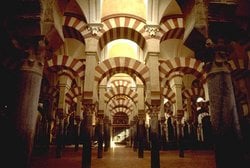
In the eighth century, nearly all the Iberian peninsula, which had been under Visigothic rule, was quickly conquered (711–718), by mainly Berber Muslims, who had crossed over from North Africa, led by Tariq ibn Ziyad. Visigothic Spain was the last of a series of lands conquered in a great westward charge by the Islamically inspired armies of the Umayyad empire. Indeed they continued northwards until they were defeated in central France at the Battle of Tours in 732. Astonishingly the invasion started off as an invitation from a Visigoth faction within Spain for support. But instead the Moorish army, having defeated King Roderic proceeded to conquer the peninsula for itself. The Roman Catholic populace, unimpressed with the constant internal feuding of the Visigothic leaders, often stood apart from the fighting, often welcoming the new rulers, thereby forging the basis of the distinctly Spanish-Muslim culture of Al-Andalus. Only three small counties in the mountains of the north of Spain managed to cling to their independence: Asturias, Navarra and Aragon, which eventually became kingdoms.
The Muslim emirate proved strong in its first three centuries; stopping Charlemagne's massive forces at Saragossa and, after a serious Viking attack, established effective defences. Indeed it became a terror in its own right to Christian neighbours, with its "al-jihad fil-bahr" (holy war at sea). Christian Spain struck back from its mountain redoubts by seizing the lands north of the Duero river, and the Franks were able to seize Barcelona (801) and the Spanish Marches), but save for these and some other small incursions in the north, the Christians were unable to make headway against the superior forces of Al-Andalus for several centuries. It was only in the eleventh century that the break up of Al-Andalus led to the creation of the Taifa kingdoms, who attempted to outshine each other in art and culture and were often at war, became vulnerable to the consolidating power of Spain's Christian kingdoms.
The Moorish capital was Córdoba, in southern Spain, the richest and most sophisticated city in all of western Europe. During this time large populations of Jews, Christians and Muslims lived in close quarters, and at its peak some non-Muslims were appointed to high offices under the some of the more lenient Muslim rulers. At its best it produced exquisite architecture and art, and Muslim and Jewish scholars played a major part in reviving the tradition of classical Greek philosophy, mathematics and science in western Europe, whilst making their own contributions to it. However, there were restrictions on non-Muslims that grew after the death of Al-Hakam II in 976. Later invasions of stricter Muslim groups led to persecutions of non-Muslims, forcing some (including Muslim scholars) to seek safety in the then still relatively tolerant city of Toledo after its Christian reconquest in 1085.
Spanish society under Muslim rule became increasingly complex, partly because Islamic conquest did not involve the systematic conversion of the much larger conquered population to Islam. At the same time, Christians and Jews were recognized under Islam as "peoples of the book", and so given dhimmi status. Most importantly, the Islamic Berber and Arab invaders were a small minority, ruling over several million Christians. Thus, Christians and Jews were free to practise their religion, but faced certain restrictions and financial burdens. Conversion to Islam proceeded at a steadily increasing pace, as it offered social and economic and political advantages. Merchants, nobles, large landowners, and other local elites were usually among the first to convert. By the 11th century Muslims are believed to have outnumbered Christians in Al-Andalus.
Muslim Spain was wealthy and sophisticated under Islamic rule. Muslims imported a rich intellectual tradition from the Middle East and North Africa, including knowledge of mathematics and science, that they helped revive. Crops and farming techniques introduced by the Arabs, led to a remarkable expansion of agriculture, which had been in decline since Roman times. In towns and cities magnificent mosques, palaces, and other monuments were constructed. Outside the cities, the mixture of large estates and small farms that existed in Roman times remained largely intact because Muslim leaders rarely dispossessed landowners. The Muslim conquerors were relatively few in number and so they tried to maintain good relations with their subjects. This relative social peace, which was already deteriorating from the late tenth century, broke down with the later, stricter, Muslim sects.
Christian reconquest
The long period of expansion of the Christian kingdoms, beginning in 722 with the Muslim defeat in the battle of Covadonga and the creation of the Christian kingdom of Asturias, only eleven years after the Moorish invasion, is called the Reconquista. As early as 739 Muslim forces were driven out of Galicia, which came to host one of Christianity's holiest sites, Santiago de Compostela. Areas in the northern mountains and around Barcelona were soon captured by Frankish and local forces, providing a base for Spain's Christians. The 1085 conquest of the central city of Toledo largely completed the reconquest of the northern half of Spain.
In 1086 the Almoravids, an ascetic Islamic sect from North Africa, conquered the divided small Moorish states in the south and launched an invasion in which they captured the east coast as far north as Saragossa. By the middle of the 12th century the Almoravid empire had disintegrated. The Battle of Las Navas de Tolosa in 1212 heralded the collapse of the great Moorish strongholds in the south, most notably Córdoba in 1236 and Seville in 1248. Within a few years of this nearly the whole of the Iberian peninsula had been reconquered, leaving only the Muslim enclave of Granada as a small tributary state in the south. Surrounded by Christian Castile but afraid of another invasion from Muslim northern Africa, it clung tenaciously to its isolated mountain splendour for two and half centuries.
The reconquest from the Muslims is one of the most significant events in Spanish history since the fall of the Roman Empire. Arabic quickly lost its place in southern Spain's life, and was replaced by Castilian. The process of religious conversion which started with the arrival of the moors was reversed from the mid 13th century as the Reconquista was advancing south: as this happened the Muslim population either fled or forcefully converted into Catholicism, mosques and synagogues were converted into churches.
Kingdom of Spain
As the Reconquista continued, Christian kingdoms and principalities developed. By the 15th century, the most important among these were the Kingdom of Castile (occupying a northern and central portion of the Iberian Peninsula) and the Kingdom of Aragon (occupying northeastern portions of the peninsula). The rulers of these two kingdoms were allied with dynastic families in Portugal, France, and other neighboring kingdoms. The death of Henry IV in 1474 set off a struggle for power between contenders for the throne of Castile, including Juana la Beltraneja, supported by Portugal and France, and Queen Isabella I, supported by the Kingdom of Aragon, and by the Castilian nobility. Following the War of the Castilian Succession, Isabella retained the throne, and ruled jointly with her husband, King Ferdinand II.
The marriage of Isabella I of Castile (1451-1504) and Ferdinand V of Aragón (1452-1516), in 1469, in Valladolid, united both crowns and effectively led to the creation of the Kingdom of Spain, at the dawn of the modern era. Isabella of Castile and Ferdinand of Aragon were known as the "Catholic Monarchs" (Spanish: los Reyes Católicos), a title bestowed on them by Pope Alexander VI. They oversaw the final stages of the Reconquista of Iberian territory from the Moors with the conquest of Granada, conquered the Canary Islands and expelled the Jews and Muslims from Spain under the Alhambra decree. They authorized the expedition of Christopher Columbus, who became the first European to reach the New World (since Leif Ericson) which led to an influx of wealth into Spain, funding the coffers of the new state that would prove to be a dominant power of Europe for the next two centuries.
Until the late fifteenth century, Castile and León, Aragón and Navarre were independent states, with independent languages, monarchs, armies and, in the case of Aragon and Castile, two empires: the former with one in the Mediterranean and the latter with a new, rapidly growing, one in the Americas. The process of political unification continued into the early 16th century. With the union of Castile and Aragón in 1479 and the subsequent conquest of Granada in 1492 and Navarre in 1512, the word Spain (España, in Spanish) began being used only to refer to the new unified kingdom and not to the whole of Hispania (the term Hispania (from which España was originally derived) is Latin and the term Iberia Greek).
Isabella ensured long-term political stability in Spain by arranging strategic marriages for each of her five children. Her firstborn, a daughter named Isabella, married Alfonso of Portugal, forging important ties between these two neighboring countries and hopefully to ensure future alliance, but Isabella soon died before giving birth to an heir. Juana, Isabella’s second daughter, married Philip the Handsome, the son of Maximilian I, King of Bohemia (Austria) and entitled to the crown of the Holy Roman Emperor. This ensured alliance with the Holy Roman Empire, a powerful, far-reaching territory which assured Spain’s future political security. Isabella’s first and only son, Juan, married Margaret of Austria, maintaining ties with the Habsburg dynasty, on which Spain relied heavily. Her fourth child, Maria, married Manuel I of Portugal, strengthening the link forged by her older sister’s marriage. Her fifth child, Catherine, married Henry VIII, King of England and was mother to Queen Mary I.
Jews expelled
If until the thirteenth century religious minorities (Jews and Muslims) had enjoyed quite some tolerance in Castilla and Aragon - the only Christian kingdoms where Jews were not restricted from any professional occupation - the situation of the Jews collapsed over the fourteenth century, reaching a climax in 1391 with large scale massacres in every major city, with the exception of Avilla. Over the next century, half of the estimated 200,000 Spanish Jews converted to Christianity (becoming "conversos"). At Ferdinand's urging, the Spanish Inquisition had been established in 1478. The final step was taken by the Catholic Monarchs, who, in 1492, ordered the remaining Jews to convert or face expulsion from Spain. Depending on different sources, the number of Jews actually expelled is estimated to be anywhere from 40,000 to 120,000 people. Over the following decades, Muslims faced the same fate and about 60 years after the Jews, they were also compelled to convert ("moriscos") or be expelled. Jews and Muslims were not the only people to be persecuted during this time period. Gypsies also endure a tragic fate. As a matter of fact, all Gypsy male were forced to serve in galleys between the age of 18 and 26 - which was equivalent to a death sentence - but the majority managed to hide and avoid arrest.
Spanish Empire
The unification of Castile and León, Aragón and Navarre became the base of what is now referred to as the Spanish Empire, the first modern global empire, and one of the largest empires in world history. In the sixteenth century, Spain and Portugal led European global exploration and colonial expansion and the opening of trade routes across the oceans, with trade flourishing across the Atlantic between Spain and the Americas and across the Pacific between East Asia and Mexico via the Philippines. Conquistadors toppled the Aztec, Inca and Maya civilizations and laid claim to vast stretches of land in North and South America. For a time, the Spanish Empire dominated the oceans with its experienced navy and ruled the European battlefield with its fearsome and well trained infantry, the famous tercios: in the words of the prominent French historian Pierre Vilar, "enacting the most extraordinary epic in human history". Spain enjoyed a cultural golden age in the sixteenth and seventeenth centuries.
This American empire was at first a disappointment, as the natives had little to trade, though settlement did encourage trade. The diseases that arrived with the colonizers devastated the native populations, especially in the densely populated regions of the Aztec, Maya and Inca civilizations, and this reduced economic potential of conquered areas. In the 1520s, large-scale extraction of silver from the rich deposits of Mexico's Guanajuato began, to be greatly augmented by the silver mines in Mexico's Zacatecas and Peru's Potosi from 1546. These silver shipments re-oriented the Spanish economy, leading to the importation of luxuries and grain. They also became indispensable in financing the military capability of Habsburg Spain in its long series of European and North African wars, though, with the exception of a few years in the seventeenth century, Spain itself (Castile in particular) was by far the most important source of revenue. From the beginning of the incorporation of the Portuguese empire in 1580 (lost in 1640) until the loss of its American colonies in the nineteenth century, Spain maintained the largest empire in the world even though it suffered fluctuating military and economic fortunes from the 1640s. Confronted by the difficulties created by empire-building, Spanish thinkers formulated some of the first modern thoughts on natural law, sovereignty, international law, war, and economics; there were even questions about the legitimacy of imperialism — in related schools of thought referred to collectively as the School of Salamanca.
Charles V
Spain's powerful world empire of the sixteenth and seventeenth centuries reached its height and declined under the Habsburgs. The Spanish Empire reached its maximum extent in Europe under Charles I of Spain (1500-1558), who was also (also known as Charles V) emperor of the Holy Roman Empire. The grandson of Isabella and Ferdinand, Charles V, Holy Roman Emperor, who was also called Carlos I of Castille and Aragon, became king in 1516, and the history of Spain became even more firmly enmeshed with the dynastic struggles in Europe. The king was not often in Spain, and as he approached the end of his life he made provision for the division of the Habsburg inheritance into two parts: on the one hand Spain, and its possessions in the Mediterranean and overseas, and the Holy Roman Empire itself on the other. The Habsburg possessions in The Netherlands also remained with the Spanish crown.
Phillip II and the wars of religion
The division of the Habsburg inheritance was to prove a difficulty for his successor Philip II of Spain (1527-1598), who became king on Charles V's abdication in 1556. Spain largely escaped the religious conflicts that were raging throughout the rest of Europe, and remained firmly Roman Catholic. Philip saw himself as a champion of Catholicism, both against the Ottoman Turks and the heretics. In the 1560s, plans to consolidate control of the Netherlands led to unrest, which gradually led to the Calvinist leadership of the revolt and the Eighty Years' War (1568-1648). This conflict consumed much Spanish expenditure, and led to an attempt to conquer England – a cautious supporter of the Dutch – in the unsuccessful Spanish Armada (1588), an early battle in the Anglo-Spanish War (1585–1604) and war with France (1590–1598).
Despite these problems, the growing inflow of American silver from mid sixteenth century, the justified military reputation of the Spanish infantry and even the navy quickly recovering from its Armada disaster, made Spain the leading European power, a novel situation of which its citizens were only just becoming aware. The Iberian Union with Portugal in 1580 not only unified the peninsula, but added that country's worldwide resources to the Spanish crown. However, economic and administrative problems multiplied in Castile, and the weakness of the native economy became evident in the following century: rising inflation, the expulsion of the Jews and Moors from Spain, and the growing dependency of Spain on the gold and silver imports, combined to cause several bankruptcies that caused economic crisis in the country, especially in heavily burdened Castile.
The coastal villages of Spain and Balearic Islands were frequently attacked by Barbary pirates from North Africa, the Formentera was even temporarily left by its population and long stretches of the Spanish and Italian coasts, a relatively short distance across a calm sea from the pirates North African lairs, were almost completely abandoned by their inhabitants. The most famous corsair was the Turkish Barbarossa ("Redbeard"). According to Robert Davis between 1 million and 1.25 million Europeans were captured by North African pirates and sold as slaves in North Africa and Ottoman Empire between the 16th and 19th centuries This was gradually alleviated as Spain and other Christian powers began to check Muslim naval dominance in the Mediterranean after the 1571 victory at Lepanto, but it would be a scourge that continued to afflict the country even in the next century.
Philip II died in 1598, and was succeeded by his son Philip III, in whose reign a ten-year truce with the Dutch was overshadowed in 1618 by Spain's involvement in the European-wide Thirty Years' War. Government policy was dominated by favorites, but it was also the reign in which the geniuses of Cervantes and El Greco flourished. Philip III was succeeded in 1621 by his son Philip IV of Spain. Much of the policy was conducted by the minister Gaspar de Guzmán, Conde de Olivares. In 1640, with the war in central Europe having no clear winner except the French, both Portugal and Catalonia rebelled. Portugal was lost to the crown for good, in Italy and most of Catalonia, French forces were expelled and Catalonia's independence suppressed. In the reign of Philip's mentally retarded son and successor Charles II, Spain was essentially left leaderless and was gradually being reduced to a second-rank power.
The Habsburg dynasty became extinct in Spain and the War of the Spanish Succession ensued in which the other European powers tried to assume control of the Spanish monarchy. King Louis XIV of France eventually "won" the War of Spanish Succession, and control of Spain passed to the Bourbon dynasty but the peace deals that followed included the relinquishing of the right to unite the French and Spanish thrones and the partitioning of Spain's European empire.
Golden age
The Spanish Golden Age (in Spanish, Siglo de Oro) was a period of flourishing arts and letters in the Spanish Empire (now Spain and the Spanish-speaking countries of Latin America), coinciding with the political decline and fall of the Habsburgs (Philip III, Philip IV and Charles II). The last great writer of the age, Sor Juana Inés de la Cruz, died in New Spain in 1695.
The Habsburgs, both in Spain and Austria, were great patrons of art in their countries. El Escorial, the great royal monastery built by King Philip II of Spain, invited the attention of some of Europe's greatest architects and painters. Diego Velázquez, regarded as one of the most influential painters of European history and a greatly respected artist in his own time, cultivated a relationship with King Philip IV and his chief minister, the Count-Duke of Olivares, leaving us several portraits that demonstrate his style and skill. El Greco, another respected Spanish artist from the period, infused Spanish art with the styles of the Italian renaissance and helped create a uniquely Spanish style of painting. Some of Spain's greatest music is regarded as having been written in the period. Such composers as Tomás Luis de Victoria, Luis de Milán and Alonso Lobo helped to shape Renaissance music and the styles of counterpoint and polychoral music, and their influence lasted far into the Baroque period. Spanish literature blossomed as well, most famously demonstrated in the work of Miguel de Cervantes, the author of Don Quixote de la Mancha. Spain's most prolific playwright, Lope de Vega, wrote possibly as many as one thousand plays over his lifetime, over four hundred of which survive to the present day.
The Enlightenment
Philip V, the first Bourbon king, of French origin, signed the Decreto de Nueva Planta in 1715, a new law that revoked most of the historical rights and privileges of the different kingdoms that conformed the Spanish Crown, unifying them under the laws of Castile, where the Cortes had been more receptive to the royal wish. Spain became culturally and politically a follower of absolutist France. The rule of the Spanish Bourbons continued under Ferdinand VI and Charles III.
Under the rule of Charles III (1716-1788) and his ministers, Spain embarked on a program of enlightened despotism that brought Spain a new prosperity in the middle of the eighteenth century. After losing alongside France against the United Kingdom in the Seven Years' War (1756-1763), Spain recouped most of her territorial losses in the American Revolutionary War. The reforming spirit of Charles III was extinguished in the reign of his son, Charles IV (1748-1819), seen by some as mentally handicapped. Dominated by his wife's lover, Manuel de Godoy, Charles IV embarked on policies that overturned much of Charles III's reforms. During most of the eighteenth century Spain had made substantial progress since the dark days of the mid seventeenth century. But it continued to seriously lag in the enlightenment and mercantile developments transforming other parts of Europe, most notably in the United Kingdom, France, the Low Countries and, in some respects, parts of the Holy Roman Empire. The chaos unleashed by the Napoleonic intervention would cause this gap to widen greatly.
Napoleonic Wars
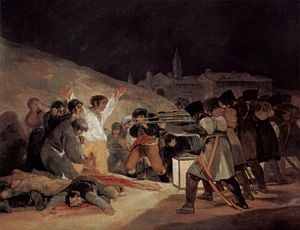
Spain initially sided against France in the Napoleonic Wars (1799-1815), but the defeat of her army early in the war led to Charles IV's pragmatic decision to align with the revolutionary French. A major Franco-Spanish fleet was annihilated, at the decisive Battle of Trafalgar in 1805, prompting the vacillating king of Spain to reconsider his alliance with France. Spain broke off from the Continental System temporarily, and Napoleon — aggravated with the Bourbon kings of Spain — invaded and deposed Charles. The Spanish people vigorously resisted the move and juntas were formed across Spain that pronounced themselves in favor of Charles's son Ferdinand.
Spain was put under a British blockade, and her colonies — for the first time separated from their colonial rulers — began to trade independently with Britain. The defeat of the British invasions of the River Plate in South America emboldened an independent attitude in Spain's American colonies. Initially, the juntas declared their support for Ferdinand, expecting greater autonomy from Madrid under the liberal constitution that the juntas had drafted. The Cortes took refuge at Cádiz. In 1812 the Cádiz Cortes created the first modern Spanish constitution, the Constitution of 1812 (informally named La Pepa).
The British, led by the Duke of Wellington, fought Napoleon's forces in the Peninsular War, with Joseph Bonaparte ruling as king at Madrid. The brutal war was one of the first guerrilla wars in modern Western history; French supply lines stretching across Spain were mauled repeatedly by Spanish guerrillas. The war in Iberia fluctuated repeatedly, with Wellington spending several years behind his fortresses in Portugal while launching occasional campaigns into Spain. The French were decisively defeated at the Battle of Vitoria in 1813, and the following year, Ferdinand was restored as King of Spain.
1812 constitution
The Spanish Constitution of 1812 was promulgated by the Cádiz Cortes, the national legislative assembly of Spain acting while in refuge. At the time the Cortes adopted the Constitution, they were taking refuge at Cádiz from the Peninsular War, which the Spanish call the Guerra de la Independencia, a war against the French Empire and the installed King Joseph. Several basic principles were soon ratified: that sovereignty resides in the nation, the legitimacy of Ferdinand VII as King of Spain, and the inviolability of the deputies. The Cortes of Cádiz worked feverishly, and the first written Spanish constitution was promulgated in the city of Cádiz on March 12, 1812.
Carlist War
Dissension and crisis
Monarchy restored
World War I
Dictatorship
Second Spanish republic
Spanish Civil War
Franco dictatorship
World War II
Post-war Spain
Economic miracle
Franco regime ends
Transition to democracy
Suarez
Attempted coup
Gonzales era
Aznar administration
Zapatero era
xxxxx
From the Renaissance to the nineteenth century
x x
A series of long and costly wars and revolts followed in the early 17th century, and began a gradual decline of Spanish power in Europe from the 1640s.
The middle and latter 17th century saw a grim decline and stagnation under the drifting leadership of the last Spanish Habsburgs. The lingering, "decline of Spain" after a long period of considerable growth since the Black Death in the 14th century, was partly due to its successes in the 15th and 16th centuries that gave rise to the treasure fleets across the Atlantic and the Manila galleons across the Pacific, which, combined with the earlier political, social and military adaptations, made Spain the most powerful nation in Europe from the beginning of the 16th century until the middle of the 17th century.
The rapid growth of these silver shipments in the second half of the 16th century, after the opening of the American mines, engendered inflation that undermined Spanish trades and commerce (never very large in the Iberian Peninsula, which wasn't highly populated, thus much of the manufactures and finance were diverted to peripheral parts of the Empire - when related to the Peninsula, that is to say - like Flanders or third countries like The Netherlands, northern Italy and other nearby countries like England or the German speaking States).
Worsening matters were the wars defending the global empire against envious European rivals, internal successions and the European wars (Eighty Years' War and Thirty Years' War) in fighting for the Habsburg's dynastic and religious interests (Counter Reformation).
Particularly the Thirty Years' War must be accounted as an on and off but almost continuous conflict which drained Spanish resources into war in Central Europe thus heavily burdening the Empire's economy. During this vast war, the Spanish Crown attempted to meet its needs by tampering with the silver content of the currency, leading to severe bouts of inflation and deflation. A steep economic and demographic decline in the Empire's overly burdened and plague ridden lynchpin (Castile), vast grants of land to the Church and the Habsburg's restoration of power to an increasingly self-serving nobility, also undermined the empire.
Reasons for this war were both dynastic and religious. It should be stressed at this point, for a better understanding of the phenomenon, that the moral commitment of the Spanish Empire to the Catholic Church by that time was total and the Spanish Kings often waged war more in terms of genuine faith against the rising Protestantism rather than based in any national interest.
A fog of officially sanctioned orthodoxy gradually smothered a once vibrant and diverse intellectual life. The resentment of ordinary peasants and labourers found expression in implicating the nobility of Moorish ancestry and the churchmen of hypocrisy. The growing beggary forced many to live by their wits, increasing the popularity of picaresque literature. This 17th century stagnation was mirrored throughout Europe, as the growing global oceanic trade that had been pioneered by the Iberian countries, was increasingly diverted to North-Western Europe.
Controversy over succession to the throne consumed what had become an essentially leaderless country with a vast empire, and much of Europe, during the first years of the 18th century.
- Further information: War of the Spanish Succession
It was only after this war ended and a new dynasty—the French Bourbons—was installed that a true Spanish state was established when the absolutist first Bourbon king Philip V of Spain in 1707 (declared in 1714) dissolved the parliamentarist Aragon court and unified the kingdoms of Castile and Aragon into a single, unified Kingdom of Spain, abolishing many of the regional privileges and autonomies (fueros) that had hampered Habsburg rule. The British abandoned the conflict after Utrecht (1713), which led to Barcelona's easy defeat by the "absolutists" in 1714. The National Day of Catalonia still commemorates this defeat.
Following the wars at its commencement the 18th century saw a long, slow recovery, with an expansion of the iron and steel industries in the Basque Country, a growth in ship building, some increase in trade and a recovery in food production and a gradual recovery of population in Castile. The new Bourbon monarchy drew on the French system in trying to modernize the administration and economy, in which it was more successful in the former than the latter. In the last two decades of the century, with the ending of Cadiz's royally granted monopoly, trade experienced an extraordinary growth (from a relatively low base) and even witnessed the initial steps of an industrialization of the textile industry in Catalonia. Spain's effective military assistance to the rebellious British colonies in the American War of Independence won it renewed international standing.
The early nineteenth century
The reformatory efforts of Charles III and his ministers Ensenada and Floridablanca led to a profound gap between partisans of the Enlightenment (Afrancesados) and the partisans of the Old Spain. The subsequent war with France in 1793 (French Revolutionary Wars) polarized the country in an apparent reaction against the Gallicised elites. The "Afrancesados" were a minority, with a vast portion of Spain firmly attached to the "Old Order" (even though they distrusted the persons formally representing it, Charles IV, his wife Maria-Luisa de Borbon Parma and her favourite Manuel Godoy). The disastrous Spanish economic situation (and, more specifically, the ambiguous and controversial relations with the juggernaut that was Napoleonic France), led by Godoy, ended with his overthrow at the Mutiny of Aranjuez on March 17th 1808 and forced the abdication of Charles IV and his son Ferdinand, Prince of Asturias, in Bayonne later that year, in favour of Joseph Bonaparte (aka Jose I or Pepe Botella). The abdication was masterminded by Napoleon, who distrusted the uncertain ally that was House of Bourbon Spain and detested the House of Bourbon. The Afrancesados had high expectations of the nomination of Joseph Bonaparte as king, even though he was not of royal blood and a foreigner, while the rest of Spain regarded him with scorn. The new, meek, monarch was sincere in his desire to reform the country for the benefit his subjects but the fast pace of events overwhelmed him. In May 2, 1808, the people of Madrid rose in arms against the French army, commanded by Marshall Joachim Murat (the uprising was immortalized by Goya in his masterpiece The Third of May 1808). Since this was the first and sole time in Modern Spain's history that the country was in foreign hands, it can be regarded as Spain's first nationalistic rebellion. The ensuing repression was swift and merciless, but it could not avoid the fact that Napoleonic rule in Spain would be anything but peaceful. A massively destructive war known to the Spanish as the War of Independence and to the English as the Peninsular War followed, savaging the country with its cruelty. With the exception of the Battle of Bailen (July 18-22, 1808), where the Spanish army was the first to defeat a Napoleonic army in Europe, there were few ranged battles. Napoleon was forced to personally intervene, bringing the Spanish army to its knees and driving the Anglo-Portuguese forces out, but triggering a massive guerrilla war as a result. The guerrillas, aided by Wellington's Anglo-Portuguese army, were effective, their action combined with Napoleon's disastrous invasion of Russia, led to the ousting of the French from Spain in 1814, and the return of king Ferdinand VII (aka El Deseado).
Consequences of the Napoleonic rule in Spain
The French invasion had numerous consequences for Spain. The war proved disastrous for Spain's economy, reversing the improvements of the late 18th century. It also brought a political and territorial legacy, but would also leave a deeply divided country prone to great political instability for over a century. In 1812, the Liberal Courts of Cádiz redacted a Constitution, bringing to the country a new form of government, and one by which future monarchs would have to rule, more or less willingly. The power vacuum between 1808 and 1814 had enabled local juntas in the Spanish colonies in America to rule independently. Starting as early as 1809, the continent started freeing itself from Spanish rule; by 1825 with the exceptions of Cuba, Puerto Rico and the Philippines, and a number of Pacific Islands Spain had lost all its colonies in Latin America. The Trienio Liberal (1820-1823).
At the end of the 19th century, Spain lost all of its remaining old colonies in the Caribbean and Asia-Pacific regions, including Cuba, Puerto Rico, Philippines, and Guam to the United States after unwittingly and unwillingly being thrust into the Spanish-American War of 1898. In 1899 Spain sold its remaining Pacific possessions to Germany.
"The Disaster" of 1898, as the Spanish-American War was called, gave increased impetus to Spain's cultural revival (Generation of '98) in which there was much critical self examination, and relieved it from the burden of its last major colonies. However, political stability in such a dispersed and variegated land, caught between pockets of modernity and large areas of extreme rural backwardness and strongly differentiated regional identities and deep divisions over legitimacy originating from the Napoleonic period, would elude the country for some decades yet, and was ultimately imposed only by a brutal dictatorship in 1939.
The 20th century initially brought little peace; Spain played a minor part in the scramble for Africa, with the colonization of Western Sahara, Spanish Morocco and Equatorial Guinea. However the area assigned to Spain was mostly abrupt terrain populated by warlike tribesmen with an age-old history of fighting outsiders. A poorly planned and led advance into the interior due to political pressure led to military disaster in Morocco in 1921. This contributed to discrediting the monarch and worsened political instability. A period of dictatorial rule under General Miguel Primo de Rivera (1923–1931) ended with the establishment of the Second Spanish Republic. The Republic offered political autonomy to the Basque Country, Catalonia and Galicia (where the autonomy did not have any effect due to the civil war) and gave voting rights to women.
In the elections in February 1936, the left-wing coalition Popular Front won a narrow victory over the right-wing National Front coalition, but tension continued to mount with the destruction of Church property and an increasing number of politically-motivated murders, including that of prominent right-wing leader José Calvo Sotelo. In July, a number of generals attempted a military takeover which they had been planning for months. The coup failed to topple the government and the Spanish Civil War (1936-39) ensued. After nearly three years of bitter struggle, Nationalist forces led by General Francisco Franco emerged victorious with the support of Germany and Italy. The Republican side was supported by the Soviet Union and Mexico, but was crucially left isolated through the British-led policy of Non-Intervention. The Spanish Civil War has been called the first battle of the Second World War. Spanish involvement in the Second World War was in fact a continuation of its civil war, as the ideological conflicts involved had much in common (but also some important differences), despite Franco's official policy of neutrality and non-belligerency during the years of Axis success. In 1940, Francisco Franco and his brother-in-law, the foreign minister, Ramón Serrano Súñer, met Adolf Hitler in Hendaye (then in German-occupied France) to discuss Spanish participation in World War II as part of the Axis. This short trip across the border was the only time Franco left Spain during his long dictatorship. No agreement was reached and Spain remained neutral though sympathetic.
Over a hundred thousand highly motivated Spanish Civil War veterans were to give both sides the benefit of their experience throughout the Second World War in Europe, the Eastern Front and North Africa. A number of the most effective forces in the French Resistance were Spanish as was the 9th Armoured Company that spearheaded Général Leclerc's 2nd Armoured Division's liberation of Paris. On the other side, about 40,000 Spaniards fought against the Soviet Union in the Wehrmacht's División Azul (Blue Division).
The only legal party under Franco's regime was the Falange española tradicionalista y de las JONS formed in 1937 by the forceable fusion of the pseudo-fascist Falange and the monarchist Carlist movement. The party emphasized anti-Communism, Catholicism, nationalism, and imperial expansion and was one of the regime's major instruments of internal control.
After World War II, being one of few surviving authoritarian regimes in Western Europe, Spain was politically and economically isolated and was kept out of the United Nations until 1955, when it became strategically important for US president Eisenhower to establish a military presence in the Iberian peninsula. Eisenhower, signed a treaty with Franco in 1953 to build the military air base in Torrejón de Ardoz (this base had nuclear weapons) some 20km east of Madrid, the naval base of Rota, Cádiz (also with nuclear weapons in submarines), and the air bases of Morón de la Frontera, Seville, and Zaragoza. This opening to Spain was aided by Franco's opposition to Communism. In the 1960s, Spain began to enjoy economic growth (Spanish miracle) which gradually transformed it into a modern industrial economy with a thriving tourism sector. Growth continued well into the 1970s, with Franco's government going to great lengths to shield the Spanish people from the effects of the oil crisis.
Upon the death of General Franco in November 1975, his personally-designated heir Prince Juan Carlos assumed the position of king and head of state. With the approval of the Spanish Constitution of 1978 and the arrival of democracy, some regions — Basque Country, Navarra— were given complete financial autonomy, and many — Basque Country, Catalonia, Galicia and Andalusia— were given some political autonomy, which was then soon extended to all Spanish regions, resulting in what is regarded as the most decentralized territorial organization in Western Europe. In the Basque Country, moderate Basque nationalism coexists with radical nationalism supportive of the terrorist group ETA.
On January 1 1999 Spain adopted the Euro as its national currency.
Ever since the current Constitution was passed in 1978, Spain has had 5 Presidentes del Gobierno (Prime Ministers) as of September 2006: Adolfo Suárez González (1977-1981) who won the election for the Unión de Centro Democrático (UCD, now extinct), Leopoldo Calvo-Sotelo Bustelo (1981-1982) also for the UCD (under his presidency there was an attempted coup d'état on 23 February 1981), Felipe González Márquez (1982-1996) who won four consecutive elections heading the Partido Socialista Obrero Español ticket (PSOE), during his administrations Spain joined NATO and European Union) and then José María Aznar López (1996-2004) who won two consecutive elections for the Partido Popular (PP). Last in this list is current Presidente del Gobierno José Luis Rodríguez Zapatero (2004-Incumbent) again for the PSOE.
21st Century
In November 2002, the oil tanker Prestige sank near to the Galician coast, causing a huge oil spill. It has since been regarded as one of the worst environmental disasters in Spanish history.
On March 11 2004, a series of bombs exploded in commuter trains in Madrid, Spain. This act of terror killed 191 people and wounded 1,460 more, besides having a dramatic effect on the upcoming national elections. The 11 March 2004 Madrid train bombings had an adverse effect on the then-ruling conservative party Partido Popular (PP) which all the polls were giving as a sure-fire winner of the elections, thus helping the election of Zapatero's Partido Socialista Obrero Español (PSOE). There were two nights of incidents around the PP headquarters, with PSOE accusing the PP of hiding the truth by saying that the incidents were caused by ETA. These incidents are still a cause of discussion nowadays, since some factions of the PP suggest that the elections were "stolen" by means of the turmoil which followed the terrorist bombing, which was, according to this point of view, backed or fuelled by the PSOE. These incidents did interfere with the last day of campaigning when, according to the Spanish electoral system regulations, any kind of political propaganda is prohibited and PP's candidate (Mariano Rajoy) appeared in some newspapers like an interior minister.
March 14 2004 saw the PSOE party elected into government, with Zapatero becoming the new PM of Spain. Since the PSOE's election victory Zapatero's government has withdrawn Spanish troops from Iraq and legalized same-sex marriages. He also presided over the Spanish Parliament's approval of the new (and controversial) Statute of Autonomy of Catalonia. Spain has been dealing with increasing immigration since the start of the twenty-first century. With polls indicating a population increase of almost 10% in 5 years, indicating record immigration into the country. Spain currently experiences one of the highest rates of immigration in Europe, with many immigrants proceeding to other European countries, or remaining in Spain.
Government and politics
Constitutional structure
The constitutional history of Spain dates back to the constitution of 1812. After the death of dictator Francisco Franco in 1975, a general election in 1977 convened the the Spanish Parliament in its capacity as a constitutional assembly for the purpose of drafting and approving the constitution.
Spain is a constitutional monarchy, with a hereditary monarch, who is chief of state, and a bicameral parliament, the Cortes Generales. The executive branch consists of a Council of Ministers presided over by the President of Government (comparable to a prime minister), proposed by the monarch and elected by the National Assembly following legislative elections.
The legislative branch is made up of the Congress of Deputies (Congreso de los Diputados) with 350 members, elected by popular vote on block lists by proportional representation to serve four-year terms, and a Senate or Senado with 259 seats of which 208 are directly elected by popular vote and the other 51 appointed by the regional legislatures to also serve four-year terms. Suffrage is universal to all aged 18 years and over.
The Spanish judiciary has professional judges and magistrates and consists of different courts, the highest ranking court being the Supreme Court. The role of the judiciary is governed by the General Council of the Judiciary Power whose chairperson is also the chairperson of the Supreme Court. Spain uses a civil law system, with regional applications, and accepts compulsory International Court of JusticeCJ jurisdiction with reservations.
Spain was, in 2007, what is called a State of Autonomies, formally unitary but, in fact, functioning as a highly decentralized Federation of Autonomous Communities, each one with slightly different levels of self-government. The pattern of asymmetrical devolution, as used in Spain, has been described as a coconstitutionalism and the devolution process adopted by the United Kingdom since 1997 shares traits with it.
Spain was regarded as the most decentralized State in Europe in 2007, with all of its different territories managing locally their health and education systems, and with some other territories (the Basque Country and Navarre) even managing their public finances without involvement of the Spanish central government, and in the case of Catalonia and the Basque Country, equipped with their own, fully operative and completely autonomous, police corps.
Administrative divisions
Spain is divided into 17 autonomous communities: Andalusia, Aragón, Asturias, Balearic Islands, Canary Islands, Cantabria, Castilla-La Mancha, Castilla y León, Catalonia, Valencia, Extremadura, Galicia, La Rioja, Madrid, Murcia, Navarre and Basque Country. There are five places of sovereignty near Morocco: Ceuta and Melilla are administered as autonomous cities, with more powers than cities but fewer than autonomous communities; Islas Chafarinas, Peñón de Alhucemas, and Peñón de Vélez de la Gomera are under direct Spanish administrations.
Basque separatists
The Government of Spain has been involved in a long-running campaign against Basque Fatherland and Liberty (ETA), a terrorist organization founded in 1959 in opposition to Franco and dedicated to promoting Basque independence through violence. They consider themselves a guerrilla organization while they are actually listed as a terrorist organization by both the European Union and the United States. Although the current nationalist-led Basque Autonomous government does not endorse any kind of violence, their different approaches as to how to terminate ETA and their different approaches to the separatist movement are a source of tension between the central and Basque governments.
Initially ETA targeted primarily Spanish security forces, military personnel and Spanish Government officials. As the security forces and prominent politicians improved their own security, ETA increasingly focused its attacks on the tourist seasons (scaring tourists was seen as a way of putting pressure on the government, given the sector's importance to the economy, although no tourists were injured) and local government officials in the Basque Country. The group carried out numerous bombings against Spanish Government facilities and economic targets, including a car bomb assassination attempt on then-opposition leader Aznar in 1995, in which his armored car was destroyed but he was unhurt. The Spanish Government attributes over 800 deaths to ETA during its campaign of rebellion.
On 17 May 2005, all the parties in the Congress of Deputies, except the PP, passed the Central Government's motion giving approval to the beginning of peace talks with ETA, without making political concessions and with the requirement that it give up its weapons. PSOE, CiU, ERC, PNV, IU-ICV, CC and the mixed group —BNG, CHA, EA y NB— supported it with a total of 192 votes, while the 147 PP parliamentarians objected. ETA declared a "permanent cease-fire" that came into force on March 24, 2006. In the years leading up to the permanent cease-fire, the government had had more success in controlling ETA, due in part to increased security cooperation with French authorities.
Territorial disputes
Spain has called for the return of Gibraltar, a British possession on its southern coast. It was conquered during the War of the Spanish Succession in 1704 and was ceded to Britain in perpetuity in the 1713 Treaty of Utrecht. An overwhelming majority of Gibraltar's 30,000 inhabitants want to remain British, as they have repeatedly proven in referenda on the issue. The UN resolutions (2231 (XXI) and 2353 (XXII)) call on the UK and Spain to reach an agreement to resolve their differences over Gibraltar. According to Spain, these resolutions overrule the Treaty of Utrecht. However, Article 103 of the UN Charter makes clear that the right of self-determination of the people of Gibraltar is the paramount and overriding principle. There is also dispute regarding the demarcation line. Gibraltar is officially a non-self governing territory or colony according to the UN.
Morocco claims the Spanish cities of Ceuta and Melilla and the Vélez, Alhucemas, Chafarinas, and Perejil islands, all on the Northern coast of Africa. Morocco points out that those territories were obtained when Morocco could not do anything to prevent it and has never signed treaties ceding them, Morocco didn't even exist in the fourteenth and fifteenth centuries when these places became Spanish possessions. Spain claims that these territories are integral parts of Spain and have been Spanish or linked to Spain since before the Islamic invasion of Spain in 711.
Portugal does not recognize Spain's sovereignty over the territory of Olivenza. The Portuguese claim that the Treaty of Vienna (1815), to which Spain was a signatory, stipulated return of the territory to Portugal. Spain alleges that the Treaty of Vienna left the provisions of the Treaty of Badajoz intact.
Foreign relations of Spain
After the return of democracy following the death of Franco in 1975, Spain's foreign policy priorities were to break out of the diplomatic isolation of the Franco years and expand diplomatic relations, enter the European Community, and define security relations with the West.
As a member of NATO since 1982, Spain has established itself as a major participant in multilateral international security activities. Spain's EU membership represents an important part of its foreign policy. Even on many international issues beyond western Europe, Spain prefers to coordinate its efforts with its EU partners through the European political cooperation mechanisms.
With the normalization of diplomatic relations with North Korea in 2001, Spain completed the process of universalizing its diplomatic relations.
Spain has maintained its special identification with Latin America. Its policy emphasizes the concept of an Iberoamerican community, essentially the renewal of the historically liberal concept of hispanoamericanismo (or hispanism as it is often referred to in English), which has sought to link the Iberian peninsula with Latin America through language, commerce, history and culture. Spain has been an example of transition from dictatorship to democracy.
Military
The armed forces of Spain consist of the Army, Navy and Air Force, a modern military force. The Armed Forces are also active members of NATO, the Eurocorps, and the European Union Battlegroups. The Commander-in-Chief is the King of Spain, Juan Carlos I.
The Spanish Army has existed continuously since the reign of King Ferdinand and Queen Isabella (late 15th century). The oldest and largest of the three services, its mission was the defense of peninsular Spain, the Balearic Islands, the Canary Islands, Melilla, Ceuta and the Spanish islands and rocks off the northern coast of Africa. The army was to be increased to about 86,000 troops (26,000 officers and 60,000 soldiers) by the end of 2007. Before 2001 mandatory military service was still in use. Currently, the Spanish Army is a fully professionalized force. In case of war or siege state, an additional force of 80,000 Civil Guards comes under the Ministry of Defence command.
The Spanish Navy (Armada) is considerable, ranking second in total tonnage, after the Royal Navy, among European NATO nations. As part of its personnel reorganization, its strength had been reduced by 10,000 to 47,300 personnel, including Marines, as of 1987. Of this number, about 34,000 were conscripts.
Although Spanish Military Aviation started with a balloon force in 1896, April 10, 1910 is the date when the Spanish military aviation was formally formed by means of a Royal Decree. On November 5, 1913, during the war with Morocco, a Spanish expeditionary squadron became the first organized military air unit to see real combat during the first organized bombing in history. The current Ejército del Aire (EdA) was not formed until October 7, 1939, at the end of the Spanish Civil War, as a successor to the Nationalist and Republican Air Forces. During World War II one air section, the Division Azul, a Spanish volunteer group fought alongside the Axis Powers on the Eastern Front.
Economy
What is now the ninth largest economy in the world inherited a regulated economy from Francoism as this started to fade out in 1975.
Francoism initiated in the '60s a set of deregulating moves away from its initial total control of the economy; these, along with large infrastructure projects, resulted in the paramount economic growth almost overnight which came to be known as the "Spanish Miracle".
However, by Franco's death and the dawn of the constitutional monarchy, interventionism was still widespread: basic products like bread and sugar had their prices fixed by the government, large public firms controlled all sectors regarded as strategic (telephone, tobacco, petrol, etc.), shops had fixed opening and closing times (although this too existed, in other European countries, such as Germany), both passive and active interest rates were fixed by the government, etc. All these rigidities and more were made obvious by the 1973 oil crisis, which terminated the previous expansion cycle and unleashed a roughly 10 years period of severe industrial crisis (1975-1985). This blow stressed the need to modernize the economy and join the European Community.
Spain's accession to the European Community, later the European Union (EU), in January 1986 ushered the country into opening its economy, modernize its industrial base and revise economic legislation. In doing this effort -supported from the EU with amounts of funds from the European Regional Development Fund- Spain greatly improved infrastructures, increased GDP growth, reduced the public debt to GDP ratio, reduced unemployment from 23 percent to 10 percent, and reduced inflation to under 3 percent.
The Spanish economy boomed from 1986 to 1990 averaging five percent annual growth. After a European-wide recession in the early 1990s, the Spanish economy resumed moderate growth starting in 1994. Spain's mixed capitalist economy supports a GDP that on a per capita basis is 80 percent that of the four leading West European economies.
The center-right government of former President José María Aznar successfully worked to gain admission to the first group of countries launching the European single currency (the euro) on 1 January 1999. The Aznar administration continued to advocate liberalization, privatization, and deregulation of the economy and introduced some tax reforms to that end. Unemployment fell steadily under the Aznar administration but remains high at 8.1 percent. Growth averaging three percent annually during 2003-06 was satisfactory given the background of a faltering European economy.
The Socialist president, Rodriguez Zapatero, has made mixed progress in carrying out key structural reforms. He plans to reduce government intervention in business, combat tax fraud, and support innovation, research and development, but also intends to reintroduce labour market regulations that had been scrapped by the Aznar government. Despite the economy's relative solid footing significant downside risks remain including Spain's continued loss of competitiveness, the potential for a housing market collapse, the country's changing demographic profile, and a decline in EU structural funds.
Exports totalled $216.5-billion in 2006. Export commodities included machinery, motor vehicles; foodstuffs, pharmaceuticals, medicines, and other consumer goods. Export partners included France 18.9 percent, Germany 11 percent, Portugal 8.9 percent, Italy 8.6 percent, UK 7.8 percent, and the US 4.5 percent.
Imports totalled $317.1-billion in 2006. Import commodities included machinery and equipment, fuels, chemicals, semifinished goods, foodstuffs, consumer goods, and measuring and medical control instruments. Import partners included Germany 14.7 percent, France 13.2 percent, Italy 8.1 percent, UK 5 percent, Netherlands 4.8 percent, and China 4.8 percent.
The GDP per_capita was $26,320 in 2005, a rank of 25 out of 194 countries. The unemployment rate was 8.1 percent in 2006, and 9.8 percent of the population existed below the poverty line in 2005.
Demographics
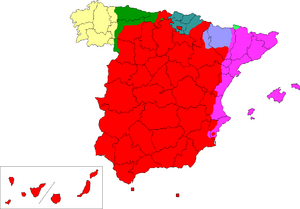
| ██ Castilian (Spanish) ██ Catalan, co-official ██ Basque, co-official ██ Galician, co-official | ██ Asturian, unofficial ██ Aragonese, unofficial ██ Aranese, co-official (dialect of Occitan) |
Population
The population of Spain, which was 44,395,286 in 2006, doubled during the twentieth century, due to the spectacular demographic boom by the 60s and early 70s. Then, after the birth rate plunged in the 80s and Spain's population became stalled, a new population increase started based initially in the return of many Spanish who emigrated to other European countries during the 70s and, more recently, it has been boosted by the large figures of foreign immigrants, mostly from Latin America (38.75 percent of them), Eastern Europe (16.33 percent), Maghreb (14.99 percent) and Subsaharian Africa (4.08 percent). Also some important pockets of population coming from other countries in the European Union are found (20.77% of the foreign residents), specially along the Mediterranean costas and Balearic islands, where many choose to live their retirement or even telework. However, the pattern of growth was extremely uneven due to large-scale internal migration from the rural interior to the industrial cities during the 60s and 70s. No fewer than eleven of Spain's 50 provinces saw an absolute decline in population over the century.
Spain has the highest immigration rate of the EU. Spain's population density, at 220 per square mile (87.8/km²) is lower than that of most Western European countries and its distribution along the country is very unequal. With the exception of the region surrounding the capital, Madrid, the most populated areas lie around the coast.
Life expectancy at birth for the total population was 79.78 years in 2007.
Ethnicity
The Spanish people have varied origins, due to Spaniards long history of invasions and migrations. Substantial populations descended from Spanish colonists and immigrants also exist in other parts of the world, most notably in Latin America. A more orthodox analysis would be used to class these groups as Spanish, based on common language, culture and a sense of shared ancestry.
Spain itself consists of various regional nationalities including the Castilians (who most strongly identify with the Spanish identity), the Catalans, Valencians and Balearics (speakers of a distinct yet related Romance language in eastern Spain), the Basques (a distinct people inhabiting the Basque country), and the Galicians, who speak a language which is very close to Portuguese. Regional diversity is important to many Spaniards and some regions (other than the ones associated with the different nationalities) also have strong local identities and dialects, such as Asturias, Aragon, the Canary Islands, and Andalusia.
The Spanish Constitution of 1978, in its second article, recognizes historic entities ("nationalities“, a carefully chosen word in order to avoid the more politically loaded "nations") and regions, inside the unity of the Spanish nation.
Since the sixteenth century, the most famous minority group in the country (though not the biggest in number) have been the Gitanos, a Roma group.
Spain harbours a number of black African-blooded people — who are descendants of populations from former colonies (especially Equatorial Guinea) who chose to be in Spanish guidance and, much more important than those in numbers, immigrants from several Sub-Saharan and Caribbean countries who have been recently settling in Spain. There are also sizeable numbers of Asian-Spaniards, most of whom are from Chinese, Filipino, Middle Eastern, Pakistani and Indian origins; Spaniards of Latin American descent are also sizeable as well.
The important Jewish population of Spain was either expelled or forced to convert in 1492, with the dawn of the Spanish Inquisition. After the nineteenth century, some Jews have established themselves in Spain as a result of migration from former Spanish Morocco, escape from Nazi repression and immigration from Argentina. The Spanish law allows Sephardi Jews to claim Spanish citizenship.
Religion
Spain was born out of religious struggle between Catholicism and, in turn, Islam, Judaism, and Buddhism. After centuries of the Reconquista, in which Christian Spaniards fought to drive out the Moors, the Spanish Inquisition sought to complete the religious purification of the Iberian Peninsula by driving out Jews, Protestants, and other nonbelievers. The Inquisition was finally abolished only in the 1830s, and even after that religious freedom was denied in practice, if not in theory. Catholicism became the state religion in 1851, when the Spanish government signed a Concordat with the Holy See that committed Madrid to pay the salaries of the clergy and to subsidize other expenses of the Roman Catholic Church as a compensation for the seizure of property in the Desamortización de Mendizábal. This pact was renounced in 1931, when the secular constitution of the Second Spanish Republic imposed a series of anticlerical measures that threatened the church's existence in Spain. Under Francisco Franco, the church's privileges were restored. In 1976, however, King Juan Carlos de Borbon unilaterally renounced the right to name the bishops; later that same year Madrid and the Vatican signed a new accord that restored to the church its right to name bishops, and the church agreed to a revised Concordat that entailed a gradual financial separation of church and state.
Roman Catholicism is the most popular religion in the country. Up to 94 percent self-identify as Catholics, whereas around six percent identify with either other religions or none at all. There are many Protestant denominations, all of them with less than 50,000 members, and about 20,000 Mormons. Evangelism has been better received among Gypsies than among the general population; pastors have integrated flamenco music in their liturgy. Taken together, all self-described "Evangelicals" slightly surpass Jehovah's Witnesses (105,000) in number. Other religious faiths represented in Spain include the Bahá'í Community. The recent waves of immigration, especially during and after the 90's, have led to an increasing number of Muslims, who have about one million members. There were around 50,000 Jews in Spain in 2007.
Over the past 30 years, Spain has become a more secularized society as the number of believers has decreased significantly. Evidence of the secular nature of contemporary Spain can be seen in the widespread support for the legalization of same-sex marriage in Spain — over 70 percent of Spaniards support gay marriage according to a 2004 study by the Centre of Sociological Investigations. Indeed, in June 2005 a bill was passed by 187 votes to 147 to allow gay marriage, making Spain the third country in the European Union to allow same-sex couples to marry.
Languages
The most prominent of the languages of Spain is Spanish (Castilian, castellano), which nearly everyone in Spain can speak as a first or second language. Other languages figure prominently in many regions:
- Basque (Vasco or Euskara) in parts of the Basque Country and Navarre.
- Catalan in Catalonia, eastern Aragon and the Balearic Islands and (in the same dialect continuum), as a variant of this, Valencian, in Valencia.
- Galician in Galicia (which also forms a dialectal continuum with Portuguese.
Spanish or Castilian is official throughout the country; the rest of these have co-official status in their respective regions and all are major enough to have numerous daily newspapers in these languages and (especially for Catalan, Basque and Galician) significant book publishing and media sectors. Many citizens in these regions consider their regional language as their primary language and Spanish, as secondary; these languages cover broad enough regions to have multiple distinct dialects.
Spanish itself also has distinct dialects around the country, for example the Andalusian and Canarian dialects, each of these with their own subvarieties, some of them being partially closer to the Spanish of the Americas, which they heavily influenced at different degrees, depending on the regions or periods, and according to different and non-homogeneous migrating or colonization processes.
In addition, there is strong and growing support for other regional languages, some of them in danger of extinction. These include :
- Astur-Leonese: Asturian in Asturias and Leonese in parts of the former Kingdom of León.
- Aragonese in northern Aragon.
- Aranese, a variety of the Gascon, which in turn is a variety of the Occitan language; a dialect spoken only in the tiny Val d'Aran in the Pyrenees, in north-western Catalonia, but enough of a live language to be co-official and used in the public schools there.
With the exception of Basque, which appears to be a language isolate, all of these are Latin derived, that is, Romance languages.
Arabic or Berber are spoken by the Muslim population of Ceuta and Melilla and by recent immigrants (mainly from Morocco and Algeria) elsewhere.
During the 1939–1975 dictatorship of General Francisco Franco, all languages except Spanish were banned from public use, as Franco wanted to create a united and uniform Spain and crush any forms or factors of separatism, especially the Basque, Catalan and (to a lesser extent) Galician movements. However, the pressure against these languages, and all repressive policies in general, loosened as time passed.
Men and women
In rural areas, men do most of the agricultural tasks, and women do domestic chores and keep the garden. Generally, many men like to cook but are reluctant to do mending and laundry. Married men and women run their domestic economies and raise their children together, although traditionally, throughout Spain, men and women pursue leisure separately, particularly in public. Men are more involved in politics, and women tend to the family's religious observance, child rearing and household management. Under Castilian law, women inherited property equally with their brothers, although this independence of control was relinquished to the husband upon marriage. Today, spouses are equal under the law. Noble women inherit family titles if they have no brothers. Women do not change their birth surnames at marriage in any part of Spain. Women work throughout the business, professional, and political worlds, a situation that was achieved without a feminist rebellion, and there are few barriers to their advancement in most kinds of work.
Marriage and the family
Spaniards today marry for mutual attraction, largely within their own social classes or to a spouse who is better off. Marriage is a partnership, and the rearing of a family is central to it. Divorce is permitted, and liaisons outside marriage are more common and accepted. Most live in nuclear-family households of parents and unmarried children. A tradition of the oldest or youngest son and wife living in the family home with the aging parents has declined. Despite the fact that families are getting smaller, the Spanish family remains extremely strong. Infants are raised with affection and good humor. The birth of children is the purpose of marriage. The threat of shame helps achieve desirable conduct.
Education
Most Spaniards see schooling as crucial. The urban working classes, value literacy and schooling beyond the obligatory age of 14. State education in Spain is free and compulsory from age six to 16 years. Children from three to five years old have the option of attending the infantil (popularly known as preescolar) or Pre-school stage, which is non-compulsory and free for all students. It is regarded as an integral part of the education system with infantil classes in almost every primary school. There are some separate Colegios Infantiles or nursery schools.
Spanish students aged six to 16 undergo primary (Colegio) and secondary school (Instituto) education, which are compulsory and free of charge. A non-evaluable religion class is taken in all schools in accordance with the doctrine of the Roman Catholic Church, and Islam or Evangelical in the schools where there are important minorities. Parents are asked when they enroll their children whether or not they wish them to take religious education, taking Civism lessons or Religious Culture, where the history of the religions is studied.Successful students are awarded a Secondary Education Certificate, which is necessary for entering further (optional) education as is Bachillerato for their University or Formacion Professional (Vocational Studies). Once students have finished their Bachillerato, they can take their University Entrance Exam (Pruebas de Acceso a la Universidad).
The universities regulate the access to their own degrees and they fix the academic prices. They can also offer unofficial post-degrees. Spain has internationally recognized universities, the most notable being the University of Barcelona which is ranked in the top 200 universities in the world in the THES - QS World University Rankings.
Class
The royal family occupies the apex of Spain's social pyramid, followed by the titled nobility and aristocratic families. In modern democratic Spain, individuals who have made their mark in business, public life, or cultural activity join the upper echelons. Wealth and family connections to power are important. Spain's middle class has expanded. Many heirs to noble titles choose not to pay the cost of claiming and maintaining them, and many titled nobles work in middle-class professions. Urbanity is valued. Education to university level is regarded as the main means of upward mobility, and Spain's university system expanded greatly to accommodate demand in the late twentieth century. Spain has a landed gentry, particularly in the southern regions, although these families do not work their land, preferring to live in the city. The wide base of the social pyramid consists of rural or urban workers, and tradesmen. Self-employed farming has always been respected, but is looked down upon as rustic. At the margins of society are itinerant Roma or Gypsies. People display their wealth through their homes, dress, jewelry, fashionable forms of leisure, educated behavior, urbane sophistication, and travel. A family's ability to take a month's vacation is an important sign of economic well-being and social status.
Culture
The Spanish culture has roots in Celtiberian, Latin, Celtic , other European countries, the Moors, Roman Catholicism, and an ongoing tension between the centralized state (dominated in recent centuries by Castile) and numerous regions and minority peoples. In addition, the history of the nation and its Mediterranean and Atlantic environment have played strong roles in shaping its culture.
Architecture
Because many of its historical buildings have remained intact today, several architectural structures in Spain, and even portions of cities, have been designated World Heritage sites. These are listed at List of World Heritage Sites in Europe: Spain.
Spain has achitectural remnants from the Stone Age, when the most expanded megalith in the Iberian Peninsula was the dolmen. The plans of these funerary chambers used to be pseudocircles or trapezoids, formed by huge stones stuck on the ground, and others over them, forming the roof.
The most characteristic constructions of the Celts were the Castros, walled villages usually on the top of hills or mountains. They were developed at the areas occupied by the Celts in the Duero valley and in Galicia. Examples include Las Cogotas, in Ávila and the Castro of Santa Tecla, in Pontevedra.
Spain was part of the Roman Empire and many areas of Spain retain significant Roman architectural remnants. The Roman aqueduct at Segovia is still in use as of 2004; Mérida, now the Extremaduran capital but once the capital of the Roman province of Lusitania, retains over 5 miles of its Roman aqueduct, Roman bridge over the River Guadiana, an arch of Trajan, and significant remnants of a Roman forum, amphitheatre, and a temple popularly accounted to have been dedicated to Diana (goddess). Another Roman bridge crosses the Tagus River at Alcántara. Lesser Roman ruins can be found in the heart of Barcelona.
Spain is home to several fine examples of medieval architecture; outside of the areas that were under Muslim control, these are primarily in the Romanesque and Gothic styles. Spain is also home to several examples of Cathedral architecture. The Drassanes in Barcelona, originally a facility for building ships and now a maritime museum, is the largest and most complete medieval secular structure in the world.
The architecture in southern Spain reflects its Moorish history. The Alhambra is probably the most famous example, showing a mixture of Islamic architecture and European influences. Significant Moorish buildings survive as far north as Zaragoza. Throughout Spain, many former mosque and synagogue buildings survive as Christian churches or, occasionally, converted to other uses. Good examples of this are the Church of Corpus Christi in Segovia and the Church of Santa María la Blanca in Toledo, both former synagogues, and the Mezquita (Spanish for "mosque"), a 10th century mosque in Córdoba, reconsecrated in 1236 as a Christian Church. The influence of Moorish architecture did not end with the reconquista: there were many prominent mudéjar architects, Muslims living and working in Christian Spain.
When the city of Barcelona was allowed to expand beyond its historic limits in the late 19th century (a suspicious Spanish government had long kept a ring of undeveloped land around the city to make it easy for the military to deploy against any unrest), the resulting Eixample ("extension"), larger than the old city, became the site of a burst of architectural energy. Most famous among the architects represented there is Antoni Gaudí, whose works in Barcelona and elsewhere in Catalonia, mixing traditional architectural styles with the new, were a precursor to modern architecture. Perhaps the most famous example of his work is the (as of 2004) still-unfinished La Sagrada Família, the largest building in the Eixample.
Alejandro de la Sota was one of the early proponents of modern architecture in Spain; the first steel framed building in Madrid is his 1961 Maravillas College Gymnasium.
Santiago Calatrava began to make his name from the 1980s and works internationally. His work is typified by a great understanding of engineering as well as nature. A notable building of his is the City of Arts & Sciences in Valencia. Enric Miralles possessed a highly esoteric style which has been compared to fellow Catalan Gaudí, and was beginning to be successful internationally, but died in 2000, at only 45 years old. His largest work, the Scottish Parliament Building was completed posthumously. The Guggenheim Museum Bilbao may be the most famous example of contemporary architecture in Spain, although the architect, Frank Gehry, is a citizen of United States and of Canadian descent.
The dry weather of Spain resulted in the importance of water fountains in Spanish urban design. In addition, ceramics figure prominently in architecture throughout Spain, especially in the tile roofs (though slate was traditional near the Atlantic coast) and the use of decorative tiles known as azulejos.
Art
Spain has an artistic heritage that includes contributions from Phoenicians, Greeks, Carthaginians, Romans, the Moors of Al-Andalus, Visigoths, Arabs and Berbers. Spain's great artists span the centuries and include El Greco (1541–1614), Diego de Velázquez (1599–1660), Francisco de Goya (1746–1828), Joaquín Sorolla (1863–1923), Joan Miró (1893–1983), Salvador Dalí (1904–1989), and Pablo Picasso (1881–1973). The decorative arts include ceramic tile, other ceramic forms, lace work, weavings, embroidery, and other craft art.
Cinema
Spanish cinema has achieved high marks of recognition as a result of its creative and technical excellence. In the long history of Spanish cinema, the great filmmaker Luis Buñuel was the first to achieve universal recognition, followed by Pedro Almodóvar in the 1980s. Spanish cinema has also seen international success over the years with films by directors like Segundo de Chomón, Florián Rey, Luis García Berlanga, Carlos Saura, Julio Medem and Alejandro Amenábar.
Clothing
Various regions of Spain have had quite distinct regional dress. Today, most people in Spain dress in a manner comparable to most other contemporary Europeans, although some regional variations persist. Dress in Extremadura and in the smaller cities of Castile remains relatively austere, even on festive occasions, while Andaluz dress on festive occasions is elaborate and ostentatious. Barcelona is one of the most stylish cities in Europe, though more restrained and with a more determinedly timeless style than Paris or Milan.
Cuisine
Spanish cuisine is made of very different kinds of dishes due to the differences in geography, culture and climate. It is heavily influenced by the variety of seafood available from the waters that surround the country. Some foods typically associated with Spain include arroz con leche, (rice with milk), which is served as a dessert, and paella, which is made with yellow rice typically garnished with a variety of meats or seafood.
Much influence on Spanish cuisine has come from the Jewish and Moorish traditions. The Moors were a strong influence in Spain for many centuries and their food is still eaten in Spain today.
Main foods include bread, legumes (chickpeas, beans, lentils), rice, garden vegetables, cured pork products, lamb, veal and beef, eggs, chickens, rabbits, locally available wild herbs, game, fish, and shellfish, cod and congeree, olives, and olive oil, orchard fruits and nuts, grapes and wine, milk, cheeses and fresh curd, honey, parsley, thyme, oregano, paprika, saffron, onions, and garlic.
Spanish dishes include: Chorizo, a paprika pork sausage; cocido, a stew with beans and meat; fabada asturiana, beans with chorizo and lard; fideuà, a noodle paella; gazpacho, a cold soup or a liquid salad; jamón, cured ham; paella, a rice dish, sangría, a wine cooler; and tortilla de patatas, potato omelette.
A small breakfast includes coffee or chocolate, and bread, breakfast cakes, packaged cookies, or dough fritters (churros). The midday meal (comida) around 2pm is traditionally the day's main meal, and features a stew, a brothy dish of legumes with potatoes, with cured pork and fresh meat. Between 6pm and 8pm, people may snack on tapas (appetizers) with a drink at a bar. Supper is a light meal of soup, eggs, fish, or cold meats eaten by families around 10pm.
Customs
The siesta—an hour-long mid-afternoon break from work—is generally in decline and the typical rhythm of the day in Spain is now similar to the European norm. Many shops and some museums (though relatively few other businesses) still split their hours into two distinct periods of opening with a two or three hour break in the middle; a paseo (stroll) in the early evening remains a common custom in many smaller cities and to some extent even in the larger ones.
Night-life starts late, with many dance clubs (even in relatively small cities) opening at midnight and staying open until dawn. During summer in Madrid, there is nothing unusual about a live musical performance being scheduled for one or two o'clock in the morning. This rhythm has developed in accordance with the hours of the sun which rises and sets one or two hours later than in the rest of Europe. The routine perhaps lessens outdoor human activity in the period of the day when temperatures are hottest.
Dance
Some of Spain's native dances can be traced back to Greek times, and Spanish dancers were renowned through the Roman Empire for their artistry. The saraband and the pavane developed and were performed by the ruling classes during the Renaissance, while the common people created their own dances like the fandango, bolero, and cachucha. Famous Spanish dances include the contradanza, flamenco, pasodoble, sardana, and jota.
Literature
The literature of Spain dates back to the jarcha, which is the lament of a lower-class woman for her absent sweetheart. It is the final three- or four-lined stanza of the muwashshah, a form of verse used by Arabic and Hebrew poets from the eleventh to the thirteenth century. The jarcha is written in Mozarabic, a Romance language spoken by the majority of the population during this period.
The Cantar de Mio Cid was written about a real man—his battles, conquests, and daily life. The poet, name unknown, wrote the epic in about 1140 and Cid supposedly died 40 years before in 1099. This epic represents realism, because nothing was exaggerated and the details are very real, even the geography correctly portrays the areas in which Cid traveled and lived. Unlike other European epics, the poem is not idealized and there is no presence of supernatural beings.
Spanish prose gained popularity in the mid-thirteenth century when King Alfonso X el Sabio of Castilla gave support and recognition to the writing form. He, with the help of his groups of intellectuals, directed the composition of many prose works including Las siete partidas, the first modern book of laws of the land written in the people's language.
During the fifteenth century the literary production increased exponentially. Some outstanding poets of this century are Juan de Mena and Íñigo López de Mendoza (Marquess of Santillana). The Spanish literature of the Middle Ages concludes with the work La Celestina by Fernando de Rojas.
The Baroque period of the seventeenth century brought the works of Miguel de Cervantes Saavedra, whose remarkable novels include La Galatea, and Don Quixote de la Mancha. The Baroque style used exaggerated motion and clear, easily interpreted detail to produce drama, tension, exuberance, and grandeur in sculpture, painting, literature, dance, and music.
Spain produced a wide range of writers and poets through the Enlightenment, the Romantic period, through nineteenth century realism, twentieth century Modernism and beyond.
Music
Spain's musical output includes a long history of innovation in Western and Andalusian classical music, as well as a domestic popular music industry, and diverse styles of folk music. Modern Spain has a number of performers in the fields of rock and roll, heavy metal, punk rock and hip hop, electronic music is also common between spaniards and djs such as dj marta or alex trackone are very well known in the spanish parties.
The best-known variety of Spanish folk music is probably flamenco, a diverse genre created by Andalusian Roma. Flamenco has been known since at least the 1770s, and has been through several cycles of dwindling popularity and rebirth. The style has produced many of the most famous Spanish musicians, including singer Camarón de la Isla and guitarist Carlos Montoya.
Outside of flamenco, regional Spanish folk music includes the distinct Basque trikitixa and accordion music, Galician and Asturian gaita (bagpipe) and Aragonese jota. Though some folk traditions have died out or are moribund, some retain great popularity and have been modernized and adapted to new instruments, styles and formats. These include the popular Celtic music of Galicia, the singer-songwriter tradition of nova canço and New Flamenco.
The first distinctly modern popular music of Spain began to appear in about 1959. Soon, Ye-Yé dominated the Spanish charts, followed by the import of American and British rock, French singers and other pop stars. Spanish music today mainly consists of pop/rock/punk bands such as El Canto Del Loco , La Oreja De Van Gogh , Edurne , and Amaral. This new type of music has dominated the charts in Spain today, and many believe it will continue to do so for some time.
Theatre
Spain has been an important centre of theatre since the Roman era, Seneca, a native of Córdoba, produced works that would influence the sixteenth and seventeenth centuries. While medieval drama focused on miracle and passion plays with religious themes, the sixteenth-century dramatist Juan del Encina helped revive classical theatrical forms, helping the emergence of a national theatre.
Sport
Sport in Spain is dominated by Fútbol, with La Liga, the country's professional league, drawing large attendances; Real Madrid and FC Barcelona are traditionally the most successful teams. The national team, however, underperforms consistently at the World Cup, although it did win the 1964 European Football Championship. Spain hosted the 1982 FIFA World Cup.
In tennis, Spain won the 2005 Davis Cup championship, with teenager Rafael Nadal leading the line. Cycle racing is a major sport, hosting the third biggest stage race in UCI ProTour, the Vuelta a España. Navarran Miguel Indurain is one of only five Spanish men to win the famous Tour de France. Recently, F1 Champion Fernando Alonso has spurred a rise in Formula One popularity in Spain.
Bullfighting is an icon for Spain, and despite slight recent declines in attendance it is still alive and well across the country, though is threatened by Animal Rights organizations. Another traditional Spanish sport is Pelota. Jai-alai, related to Pelota, is also a very popular sport which its first written references can be traced to XIII century in France. Spain has also achieved degrees of success in middle distance running, Golf, Basketball and Handball, among others.
At the 2004 Summer Olympics in Athens, Spain's athletes won 19 medals (three gold, 11 silver and five bronze), finishing 20th in the medal table. In the all-time Olympic Games medal count Spain is 34th with 30 gold medals and 97 total medals.
In basketball, Spain won the gold medal at the 2006 FIBA World Championships in Japan.
International rankings
- Reporters Without Borders world-wide press freedom index 2002: Rank 40 out of 139 countries.
- The Economist Intelligence Units worldwide quality-of-life index 2005: Rank 10 out of 111 countries (above countries like the United States of America, the United Kingdom, and France)
- Nation Master's list by economic importance: Rank 9 of 25 countries, only surpassed by G-8 members (except Russia) and Australia.
- Nation Master's list by technological achievement: Rank 18 of 68 countries.
See also
| Spain Portal |
- Autonomous communities of Spain
- Civil unions in Spain
- Communications in Spain
- Culture of Spain
- Education in Spain
- Foreign relations of Spain
- Instituto Cervantes
- List of cities in Spain
- List of municipalities in Spain
- List of Spanish birds
- List of Spanish national parks
- Military of Spain
- Music of Spain
- Places of sovereignty in North Africa
- Spanish Heraldry
- Public holidays in Spain
- Same-sex marriage in Spain
- Spanish nobility
- Sports in Spain
- Tourism in Spain
- Transportation in Spain
- SEAT automobile
- Biscuter automobile
History Related Links:
- Black Legend
- Hispania
- History of Spain
- Spanish Empire
- Latin America
References and notes
- John Hickman and Chris Little, "Seat/Vote Proportionality in Romanian and Spanish Parliamentary Elections", Journal of Southern Europe and the Balkans Volume 2, Number 2, November 2000.
- Harold Raley, "The Spirit of Spain", Houston: Halcyon Press 2001. (ISBN 0-9706054-9-8)
- George Orwell's Homage to Catalonia.
- Pritchett, V.S., The Spanish Temper (1954). Alfred A. Knopf, New York.
External links
- Spain World Fact Book 2007, accessed November 6, 2007.
- Spain Encyclopaedia Britannica Online, accessed November 6, 2007.
- Culture of Spain Countries and Their Cultures, accessed November 6, 2007.
- Maps of Spain: satellite images, relief maps, outlines and themed maps of Spanish autonomous communities, provinces and municipalities
- iberianature a guide to the environment, geography, climate, wildlife, natural history and landscape of Spain
- The Guide of towns of Spain
- Inetractive map of Spain. Calculate distances and travel directions with Google Map
- Spain: The Economist Country Briefings entry (current)
- This article contains material from the Library of Congress Country Studies, which are United States government publications in the public domain.
[1] (1988)
Government
- Casa Real.es – Official site of the Spanish Royal Family
- La Moncloa.es — Prime Minister's official site
- (Spanish) administracion.es e-government Portal
- Congreso de los Diputados — Official site of the Congress of Deputies
- El Senado – Official site of the Senate
- Ministerio de Asuntos Exteriores Ministry of Foreign Affairs
- (Spanish) INEBase — National Institute of Statistics
- Agencia Estatal de Administración Tributaria — State Tax Administration Agency
|}
Tourism
|


